Abstract
Epigenetic mechanisms have emerged as links between prenatal environmental exposure and disease risk later in life. Here, we studied epigenetic changes associated with maternal smoking at base pair resolution by mapping DNA methylation, histone modifications, and transcription in expectant mothers and their newborn children. We found extensive global differential methylation and carefully evaluated these changes to separate environment associated from genotype‐related DNA methylation changes. Differential methylation is enriched in enhancer elements and targets in particular “commuting” enhancers having multiple, regulatory interactions with distal genes. Longitudinal whole‐genome bisulfite sequencing revealed that DNA methylation changes associated with maternal smoking persist over years of life. Particularly in children prenatal environmental exposure leads to chromatin transitions into a hyperactive state. Combined DNA methylation, histone modification, and gene expression analyses indicate that differential methylation in enhancer regions is more often functionally translated than methylation changes in promoters or non‐regulatory elements. Finally, we show that epigenetic deregulation of a commuting enhancer targeting c‐Jun N‐terminal kinase 2 (JNK2) is linked to impaired lung function in early childhood.
Keywords: environment, epigenetics, WGBS, histone modifications, enhancer deregulation
Subject Categories: Chromatin, Epigenetics, Genomics & Functional Genomics; Genome-Scale & Integrative Biology; Systems Medicine
Introduction
Altered epigenetic patterns represent an attractive explanation for understanding the phenotypic changes associated with environmental exposure. By affecting DNA methylation, post‐translational histone modification, or non‐coding RNA (ncRNA) signaling, environmental factors may cause persistent perturbations of regulatory pathways and thus induce an altered susceptibility for disease (Aguilera et al, 2010). Many lines of evidence indicate that early life and in particular the prenatal period represent a window of high vulnerability to environmental impacts with consequences for disease risk later in children's life. The subsequent manifestation of a disease may occur with long latency periods as shown in the Dutch Hunger Winter study. This study revealed that starvation during pregnancy increased the risk for several diseases later in children's life including type II diabetes, cardiovascular diseases, or decreased cognitive function (Brown et al, 1995; Susser et al, 1996; Roseboom et al, 2001; Painter et al, 2005; Veenendaal et al, 2013). Experimental models suggest that the in utero nutritional environment resulting from starvation induces epigenetic modifications including altered DNA methylation (Radford et al, 2014) and the generation of small RNAs (Rechavi et al, 2014) that are inherited in the next generation.
One of the most common hazardous prenatal exposures is maternal smoking. Prenatal exposure to tobacco smoke was described as a risk factor for a multitude of different diseases in the child, including lung diseases, obesity, and cancer (Hemminki & Chen, 2006; Oken et al, 2008; Neuman et al, 2012). Several studies have focused on DNA methylation in cord blood to elucidate the influence of smoking and other prenatal exposures on the newborn's epigenome by analyzing global DNA methylation changes (i.e., in repetitive elements) or methylation of a limited number of preselected CpG probes (i.e., 27k methylation or 450k arrays) (Breton et al, 2009; Joubert et al, 2012; Murphy et al, 2012; Markunas et al, 2014; Kupers et al, 2015; Richmond et al, 2015). From these earlier epidemiological studies, information on global and site‐specific methylation changes is available, but the insights derived from those studies remain very limited. Importantly, these earlier investigations, being based on 450k methylation array data, covered only a small fraction of the genome and, for example, lack information on enhancer regulatory elements located outside of promoters.
Although changes of epigenetic modifications due to environmental cues early in life may persist over time, genome‐wide data for studying longitudinal stability of epigenetic patterns in humans are still missing. Earlier studies have shown evidence for long‐term stability of a limited number of methylation loci. However, to what extend this is a global trend, or only limited to some methylation loci is unclear, given the sparse coverage of the probes from the methylation array. In this study, we address the following questions: When and where in the genome are epigenetic marks set by environmental factors? What is the contribution of the genetic sequence variation to changes in DNA methylation? Do those changes that are associated with maternal smoking persist over years or do they appear only transiently? Furthermore, do DNA methylation changes contribute to early programming for disease?
To address these questions, we performed a comprehensive epigenetic characterization within the LINA mother–child birth cohort (Herberth et al, 2006, 2011) to dissect the link between environmental exposure and epigenetic signals. We first studied the DNA methylome at single base pair resolution in both children and their mothers around time of birth and until 4 years after birth. To decipher the regulatory role of DNA methylation changes associated with smoking, we performed histone modification ChIP‐seq of four histone modification marks to segment the genome into distinct regulatory elements and linked the environmentally associated differential DNA methylation to transcription as measured by RNA sequencing. Finally, we show that DNA methylation changes in conjunction with histone modifications are related to disease development later in children's life.
Results
Maternal smoking is associated with genome‐wide DNA methylation changes that are different between mothers and their children
A variety of studies has investigated the impact of maternal smoking on epigenetic changes in newborn children and assessed the stability of such epigenetic marks over time. Note that these studies focused on DNA methylation changes disregarding equally important changes on the chromatin level (Joubert et al, 2012; Kupers et al, 2015; Lee et al, 2015; Richmond et al, 2015). Further, these studies were performed on the basis of DNA methylation arrays covering as few as 5% of the entire set of CpG dinucleotides in the genome located primarily in promoter regions. To overcome the limitations of presently widely used DNA array methylation arrays offering only a narrow view on the DNA methylome, we here followed a radically different discovery and validation strategy (Fig 1). First, we set out to perform whole‐genome bisulfite sequencing (WGBS) in a set of mothers alongside with their children and we went further to seek functional support for our findings. For that, we performed detailed analysis of chromatin configuration changes encompassing DNA methylation changes and further studied genome‐wide changes in gene expression by RNA sequencing as a functional readout of the concerted action of DNA methylation and chromatin configuration changes. Finally, we set out to validate selected findings in the entire discovery cohort and in an independent replication cohort (Fig 1).
Figure 1. Discovery and validation strategy.
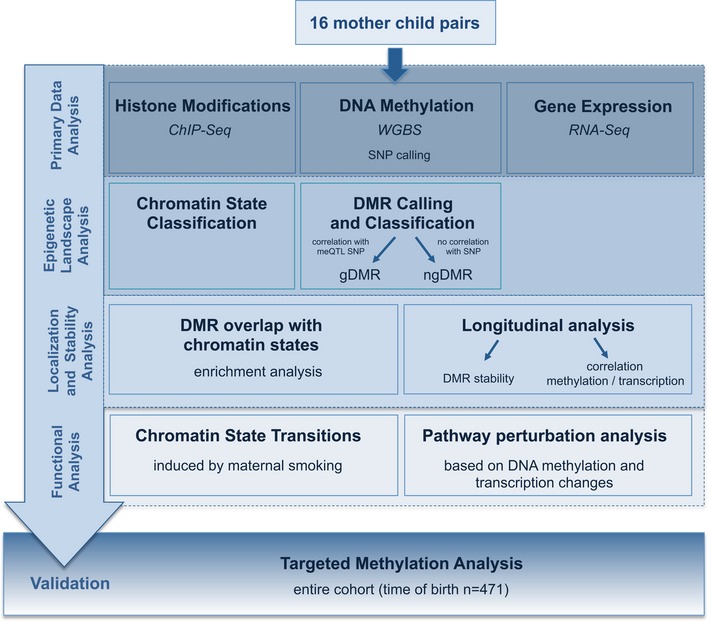
To overcome the limitations of presently widely used DNA array methylation arrays offering only a narrow view on the DNA methylome, we followed a different discovery and validation strategy. First, we performed whole‐genome bisulfite sequencing (WGBS) in a set of mothers alongside with their children. WGBS was carried out in 16 mother–child pairs, a rather small sample number compared to the typical sizes of epigenetic studies performed on DNA methylation arrays. However, we compensated this potential drawback by a subsequent comprehensive functional validation. We performed a detailed analysis of chromatin configuration and DNA methylation changes—including longitudinal stability analyses—and further studied genome‐wide gene expression by RNA sequencing as a functional readout of the concerted action of the observed epigenetic perturbations. In a targeted analysis, we finally validate selected findings in the entire discovery cohort.
To study the impact of maternal smoking on DNA methylation in both mothers and children, we performed WGBS of whole blood samples from 32 individuals (maternal blood at 36th week of gestation for eight smoking mothers and eight non‐smoking mothers and cord blood from their respective child; Table EV1; Fig EV1) at up to three different time points (for three children from smoking and three from non‐smoking mothers at year one and four, and their respective mothers at year one; Table EV1; Fig EV1; for overview of discovery/validation strategy, see Fig 1).
Figure EV1. Cohort and sample overview.
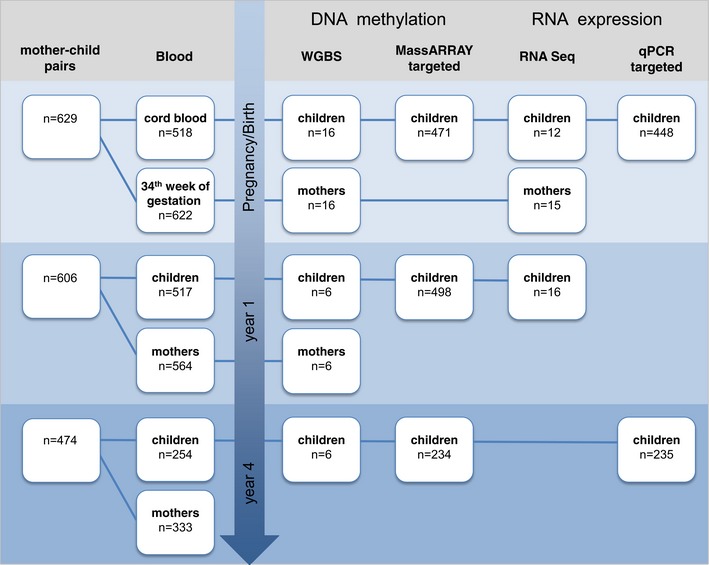
The diagram visualizes the number of mother–child pairs enrolled in the study together with the number of available blood samples (left). For the different experimental approaches, the number of samples analyzed is given starting at time of birth/pregnancy up to year 4 after birth (right).
Heterogeneity of whole blood samples may be a possible confounder in our analysis. Therefore, we excluded the possibility that differences in cell type composition in the smoking exposed/non‐exposed groups would give rise to DNA methylation changes by assessing promoter methylation levels from seven lineage markers reflecting the blood cell type composition in each sample (see Appendix Supplementary Methods). The analysis showed that the variation in cellular composition in response to tobacco smoke exposure was in the range of 1–7% for main blood cell types in mothers and children with significant reduced granulocyte and increased B‐cell numbers in newborn children from smoking mothers (Table EV2). To exclude differentially methylated regions (DMRs) that were solely caused by differences in cellular blood composition between exposed and non‐exposed samples, we used a threshold of 10% for DMR calling (Fig EV2, Appendix Supplementary Methods).
Figure EV2. FDR and number of DMRs at different methylation difference theresholds.
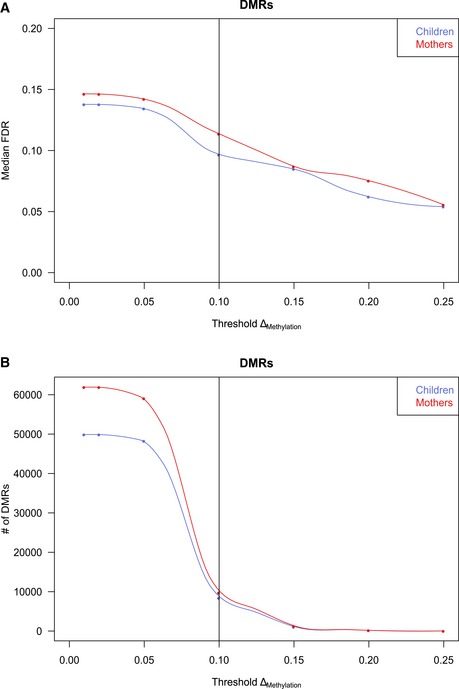
- Median false discovery rate (FDR) estimated by permutation analysis at different cutoffs for mean methylation changes of DMRs (ΔMethylation).
- Number of DMRs after filtering called at different mean methylation changes. The 10% ΔMethylation cutoff is marked and indicates a fair balance between sensitivity and specificity while offering acceptable FDRs (9.7% in children, 11.4% in mothers).
Previous studies assessing the impact of smoking on differential DNA methylation had reported changes for single CpGs in the range of 1–25% (Zeilinger et al, 2013), indicating that our requirement of a 10% change represents a conservative threshold. To ensure consistently different methylation for all samples between groups, we excluded DMRs by a moderated t‐statistics (P > 0.1) and permutation analysis. We thus identified 9743 and 8409 significant (P < 0.1, ΔMethylation > 0.1) DMRs in mothers and children, respectively, in the comparison of the smoking and the non‐smoking individuals at time of birth (Fig 2, Table EV3). Using a random shuffling procedure, we determined that the median false discovery rate (FDR) level was 12.4% for children and 11.2% for mothers (see Appendix Supplementary Methods). Note that less than 5% of these DMRs are covered by CpG probes from the 450k platform. We finally conducted a FDR analysis based on permutation analysis of DMRs with subsequent filtering with a range of thresholds for ∆Methylation (1–25%). The obtained results implied that the 10% cutoff offers an optimal balance between high sensitivity and medium specificity, which are required when comparing groups of healthy individuals (see Appendix Supplementary Methods, Fig EV2).
Figure 2. Mothers and children harbor a large number of differentially methylated regions between smokers and non‐smokers at time of birth.
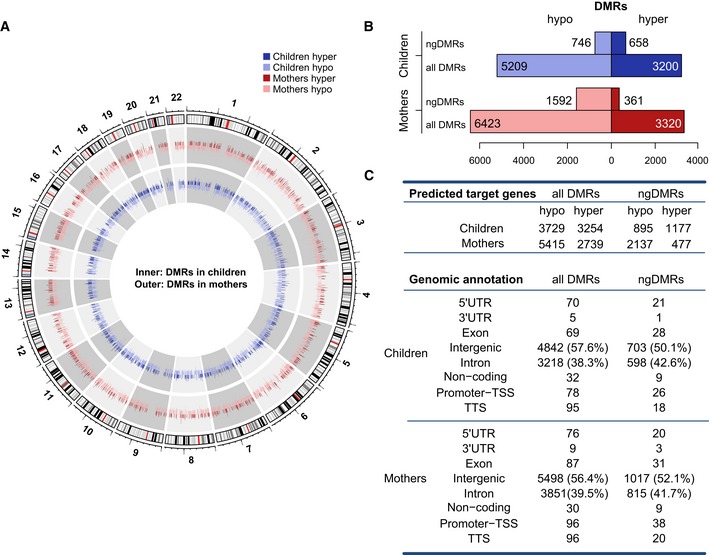
- Circular representation of DNA methylation levels for mothers (outer circle) and children (inner circle). The height of each bar indicates the methylation change between the smoking and non‐smoking group (dark hue: hypermethylation, light hue: hypomethylation).
- Bar plots represent the number of hypo‐ versus hypermethylated DMRs for all DMRs and ngDMRs in children and mothers.
- Number of genes predicted to interact with DMRs and ngDMRs. Annotation of allDMRs/ngDMRs according to genomic categories (lower panel).
Beyond environmental factors, the individual genotype also effects DNA methylation. A single nucleotide polymorphism (SNP) may destroy the CpG context and thus directly induce differential DNA methylation in cis by reducing the methylation to 0 (0.5) in case of a homozygous (heterozygous) CpG‐destroying SNP. Further, SNPs may induce differential methylation by either creating or disrupting a transcription factor binding site that may affect the level of DNA methylation (Gutierrez‐Arcelus et al, 2013) and may alter histone modifications (Kasowski et al, 2013; Kilpinen et al, 2013; McVicker et al, 2013). Given our sample size, we cannot exclude the fact that in some cases, a differential methylation between the two groups is due to genotype rather than environmental effects.
To address this issue, we performed SNP calling for each individual bisulfite sequencing sample using the bisulfite‐conversion‐aware SNP caller Bis‐SNPs (Liu et al, 2012). To distinguish between environmental and genotype‐associated differential DNA methylation, we categorized the DMRs into two groups. Whenever we found a SNP in the neighborhood (± 5 kb) of a DMR, for which the genotype was statistically significantly correlated (at 10% FDR, see Appendix Supplementary Methods) with methylation of this DMR, we call this SNP a meQTL‐SNP (methylation quantitative trait locus) for this DMR (see Fig EV3). The corresponding DMR is then termed a potentially genetically influenced DMR and abbreviated as gDMR in the following. All DMRs that are not associated with any meQTL‐SNP in their neighborhood are presumably not influenced by the genotype and thus termed non‐genetically influenced DMR (ngDMR). Even with this highly stringent definition, we retain about 17–20% (1404/8409 in children and 1953/9743 in mothers) of all DMRs as ngDMRs that do not have an apparent correlation with the underlying genetic sequence variation. In summary, we determined a set of 1404 (1953) DMRs in children (mothers) at time of birth, which are not related to genotype effects and are likely enriched in regions for which the environmental cue drives methylation changes.
Figure EV3. meQTL distinguish gDMR and ngDMR.
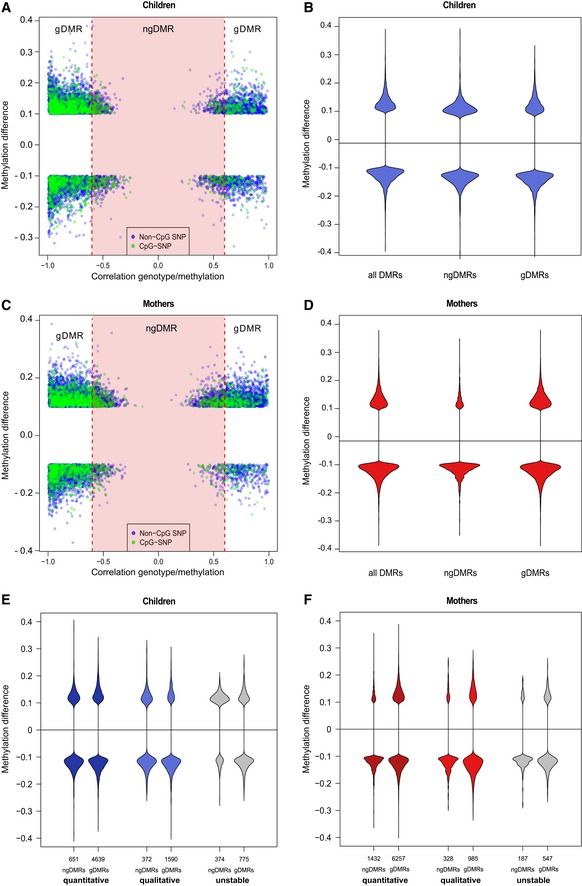
-
A–DEach DMR is associated with its most highly associated SNP within ± 5 kb, and each dot represents a DMR/SNP association. The x‐axis shows the level of correlation between genotype and methylation level, and the y‐axis shows the methylation difference for the DMR between the smoking and non‐smoking group. DMRs associated with a CpG‐destroying SNP are highlighted in green. A gDMR is defined as a DMR, which has an associated neighboring SNP with an absolute correlation above 0.6 (red vertical lines, FDR 10%), and the remaining DMRs are defined as ngDMRs (red shaded area). The effect of the 10% cutoff on the methylation difference is seen in this plot. Violin plots in (B, D) show the methylation difference in all DMRs, ngDMRs, and gDMRs.
-
E, FMethylation differences are shown for the various DMR stability classes, distinguishing ngDMRs (left in violin plot pairs) from gDMRs (right violin plot in each pair).
DNA methylation changes due to maternal smoking are stably maintained over years of life
It has been discussed controversially whether DNA methylation remains stable over longer periods of time or whether there is a general loss of methylation associated with aging (Heyn et al, 2012; Raddatz et al, 2013). Previous studies based on 450k data have shown some examples of CpGs whose methylation levels are stably maintained over years (Guida et al, 2015; Lee et al, 2015; Richmond et al, 2015). For example, Richmond et al described 3 CpGs showing a stable methylation difference related to early tobacco exposure persisting until the age of 17. Our population‐based cohort offers the unique opportunity to study longitudinal DNA methylation stability in one and the same individual by comparing two different time points separated by several years for all CpGs in the genome. We performed WGBS sequencing for six mothers and their children (three smoking and three non‐smoking; Fig EV1, Table EV1 for sample overview) 1 year after birth and for the same six children 4 years after birth (for a prototypical example see Fig 3A).
Figure 3. Differentially methylated regions show high stability over time.
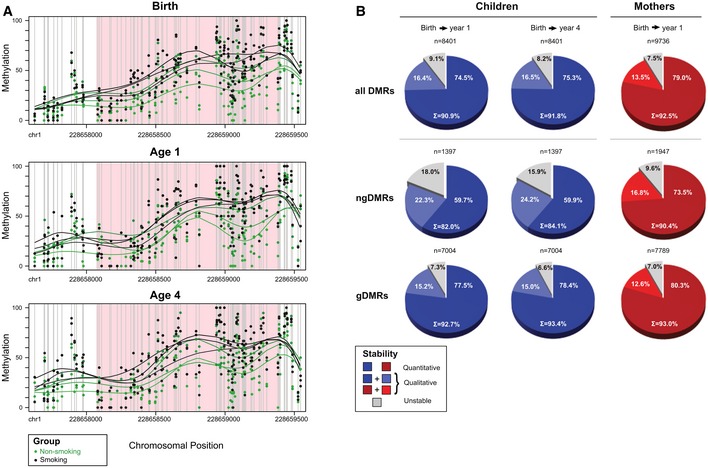
- Example of an intergenic ngDMR located 8,965 bp away from the TSS of miR‐466‐6A. Green dots indicate the raw methylation values for non‐smoking samples for all 48 CpGs in the region, while black dots indicate the raw methylation of children from smoking mothers. Lines represent smoothed methylation levels. Methylation differences of 14.5, 13.5, and 12.5%, at time of birth, one year after birth, and four years after birth, respectively, show a strong, quantitative stability of the differential hypermethylation at this locus.
- Global analysis over all DMRs, ngDMRs, and gDMRs (from top to bottom row) in mothers and children shows stability of methylation using both quantitative criteria (decrease in absolute mean methylation difference between smokers and non‐smokers should not exceed 5%) as well as qualitative criteria (direction of differential methylation should remain identical irrespective of the absolute methylation change). As expected, genetically determined gDMRs are more stable than their non‐genetically determined counterparts. Still, 90.4% (82–84.1%) of the ngDMRs show longitudinal stability in mothers (children).
To assess the stability of methylation over time within one individual compared to other individuals, we performed hierarchical clustering of all CpGs located within ngDMRs with coverage > 10 (n = 4682 in children, n = 7857 in mothers). Interestingly, the methylomes from the same individual at different years (children: time of birth, 1 and 4 years thereafter; mothers: time of birth and 1 year thereafter) clustered perfectly (Fig EV4A and B) even though we had removed all genotype‐associated gDMRs prior to clustering. This suggests that a large fraction of specific DNA methylation sites is stably maintained over at least 4 years in children and over 1 year in mothers.
Figure EV4. Temporal DMR stability assessment by clustering DNA methylation of CpGs in ngDMRs.
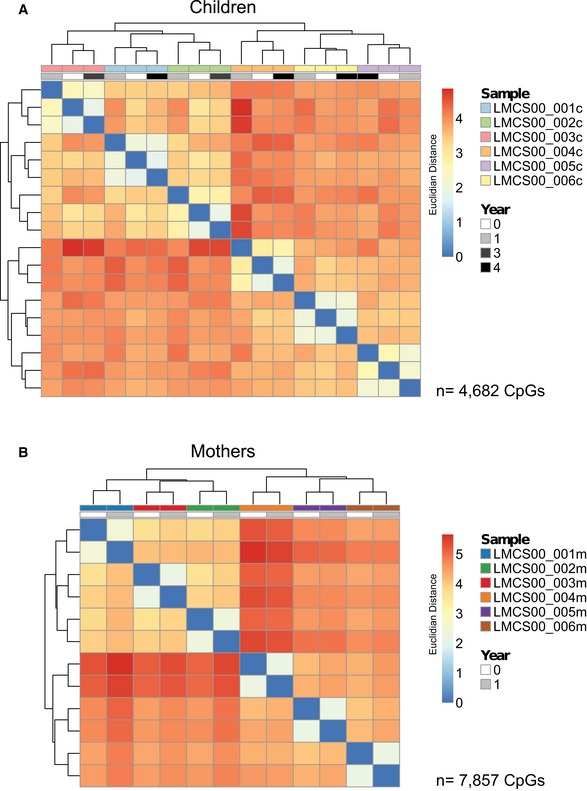
-
A, BHierarchical clustering (Euclidean distance) of methylation of all CpGs in ngDMRs that are not subject to SNPs in any sample. Only CpGs with a minimum coverage of 10 reads in all samples were considered. Clustering occurs by sample, not by year, suggesting high maintenance of CpG methylation levels for each sample over time. (A) Children (n = 4,682 CpGs), (B) mothers (n = 7,857 CpGs).
Next, we conducted a genome‐wide analysis to assess whether DMRs called at time of birth would remain differentially methylated 1 year after birth. Using the hyper‐ and hypomethylated regions determined at time of birth, we assessed whether these regions remained in their respective methylation state. In 82% (90.4%) of all ngDMRs in children (mothers), there was still a hypermethylation and hypomethylation 1 year after birth corresponding the methylation change observed at time of birth (qualitative stability, Fig 3B, middle panel). Even with the additional constrain that the maximum decrease/increase was ≤ 5% of the methylation level at time of birth, ngDMRs were retained in 73.5% in mothers and in 59.7% in children (quantitative stability, Fig 3B, middle panel). In children, differential DNA methylation remains at the same level 4 years after birth. Note that the level of stability only increased by 2.6% in mothers and 10.7% in children, respectively, comparing qualitatively stable ngDMRs with stable gDMRs (Fig 3B lower panel). Thus, the contribution of the genotype to longitudinal stability of differential DNA methylation was considerably low. In summary, maternal smoking is associated with differential DNA methylation that is persistent in mothers and children up to 4 years after birth.
Tobacco smoke‐associated DNA methylation changes correlate with hypervariable chromatin
To evaluate whether differential DNA methylation correlated with active or repressive regulatory elements in the genome, we mapped histone modifications by ChIP‐seq for six mothers and their children for which we already performed WGBS, around year four after birth (Table EV1). We selected four histone marks to delineate active/poised elements (H3K4me1 and H3K27ac), separated as enhancers or promoters based on proximity to a gene's TSS, as well as repressive elements (H3K9me3 and H3K27me3; Fig 4A). Bivalent states were defined by co‐occurrence of active and repressive marks.
Figure 4. Chromatin states built from histone marks show specific patterns of transition between non‐smokers and smokers.
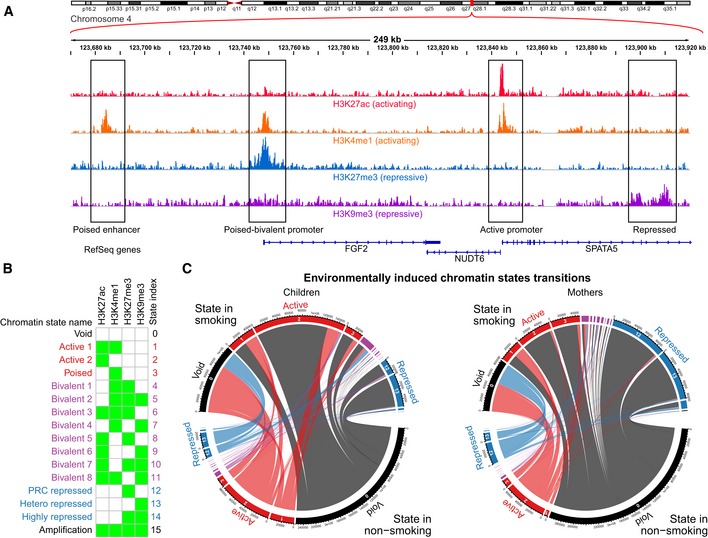
- Visualization of four histone mark read densities over 249 kb of chromosome 4 representing active marks (H3K27ac and H3K4me1) and repressive marks (H3K27me3 and H3K9me3). This region illustrates examples of (boxed from left to right): a poised enhancer upstream of FGF2 (exhibiting H3K4me1, but lacking the active signature of H3K27ac); a bivalent promoter of FGF2 (with co‐occurring active H3K4me1 and repressive H3K27ac at the promoter); active promoters marks around the TSS of NUDT6 and SPATA5 (displaying the 2 active marks of H3K27ac and H3K4me1); and repressive marks in the gene body of SPATA5 (H3K9me3), which we observe in the intron of some expressed genes.
- Chromatin state model derived from all samples representing all possible 16 states. The states were reorganized and named according to biologically relevant chromatin states representing: lack of signal (state 0, “Void”); active states (states 1–3, in red); bivalent states, showing a combination of both active and repressive marks, organized by the proportion of the genome that they represent on average (states 4–11, in purple); repressed states (states 12–14, in blue); and a state representing co‐occurrence of all marks, most likely representing genomic amplifications (state 15, “Amplification”).
- Chord diagram of chromatin state transitions in unstable regions of chromatin. The plot shows the transitions from non‐smoking to smoking for children and mothers, where the size of the outer segments represents the amount of chromatin undergoing transitions from one state to another and the width of the ribbons represents the amount of a single state transiting to another chromatin state. The scale of segment size and ribbon width are comparable between mothers and children. The outer segments and ribbons are colored according to transition to/from void, active, bivalent, repressed, and amplified as black, red, purple, blue, and black, respectively. It can be observed that in children, there is a net overall transition to a more hyperactive chromatin state (i.e., gain of twice as much active chromatin compared to repressed), which is not observed in the mothers who have a more balanced gain of both active and repressive states.
To segment the genome into distinct functional elements, ChromHMM (Ernst & Kellis, 2012), a Hidden Markov model‐based approach, was trained to cover all 16 possible combinations of the four histone modifications (Fig 4B) and then applied to segment the genome of each individual. Note that we started with a fine‐grained definition of 16 chromatin states, but most of the subsequent analysis is done by collapsing the three active and repressive states into an active and repressive meta‐state, respectively. The vast majority (91% in mothers, 90.8% in children; Table EV4) of the genome across all individuals was not covered by any of the four histone marks (background state “void”). The three active/poised enhancer and active promoter states in children or mothers covered about 4.0 and 3.3%, respectively, of the genome, whereas corresponding values for the three repressive states were 1.8 and 2.2%. The remaining part of genomic loci was in a bivalent state and carried both activating and repressive marks simultaneously.
Next, environmentally associated transitions between chromatin states were identified from a comparison of non‐smoking and smoking individuals (Fig 4C; Table EV5). For mothers, we observed slightly more transitions to repressive states than to active (29.7% active versus 41.7% repressive transitions). In children, the vast majority (43.9%) of transitions were into active states, whereas transitions into repressive state were much less frequent (17.4%). This suggests that maternal smoking is associated with a hyperactive chromatin state in their children. While genome‐wide chromatin state transitions were only statistically significant for transitions into repressed states in mothers and into bivalent states in children and in mothers, all of the transitions overlapping with ngDMRs were statistically significant (Table EV5). These significance levels were much more pronounced within ngDMRs, while all transitions within gDMRs for children reach only borderline significance levels. Together with our observation of a significant enrichment (2.4 × in children and 3.0 × in mothers) of variable chromatin in the ngDMRs, these findings suggest that much of the chromatin dynamics is strongly linked with differential methylation related to maternal smoking.
Tobacco smoke exposure is associated with epigenetic reprogramming of regulatory genomic elements
Only a minor fraction of DMRs co‐localized with regions close to TSS (Fig 2C). Thus, we examined whether the remaining DMRs fall into active or repressive regulatory genomic elements outside of the TSS. First, we defined active/poised (state 1–3) and repressive (state 12–14) enhancer meta‐states (see genome segmentation above and Appendix Supplementary Methods for details). Note that active regulatory elements outside of the TSS were considered to be active/poised enhancers based on their ChIP‐seq profile, whereas active regulatory elements in proximity of TSS were considered as active promoters. About twice as many DMRs were located in active regulatory elements outside TSS (“enhancers”) than close to TSS (“promoters”) both in mothers and in children (Fig 5A and Table EV7). This trend is observed for all DMRs, but also for ngDMRs and gDMRs separately. For repressive regulatory elements, the ratio between DMRs in such elements was approximately 7:1 when comparing regions outside and in proximity of TSS. This stronger enrichment of differential methylation in regulatory regions outside TSS was not a mere consequence of the relatively small genomic size of the TSS region. Rather, by permutation analysis (see Appendix Supplementary Methods for details), we observed a highly significant (P = 1.69e‐66 for mothers, P = 1.74e‐55 for children) enrichment of ngDMRs in enhancers both in mothers and in children (Fig 5A and Table EV7). The enrichment of ngDMRs in promoters was considerably lower (P = 3.37e‐23 for mothers and P = 6.26e‐25 for children). Similarly, ngDMRs in repressive elements showed a highly significant enrichment outside TSS (P = 9.33e‐16 for mothers and P = 1.89e‐18 for children), but considerably lower significance (P = 1.56e‐4 for mothers and P = 5.07e‐3 for children) in promoters. These results suggest that environmentally associated differential methylation targets enhancer elements or repressive elements predominantly outside TSS.
Figure 5. Differential methylation mostly targets distal intragenic regulatory regions.
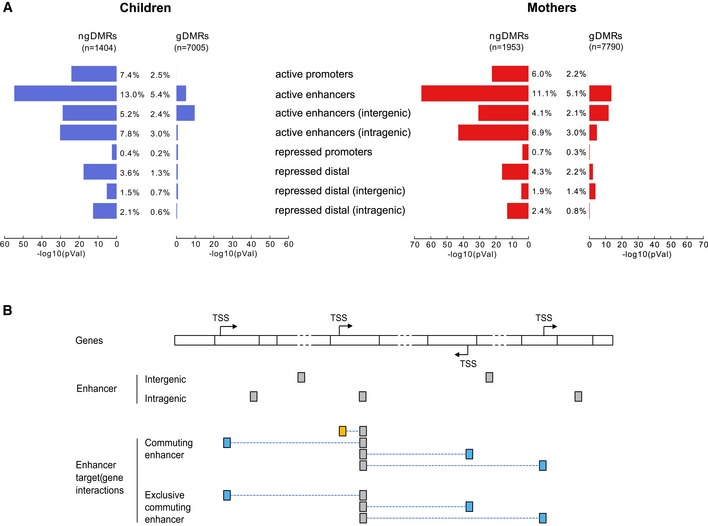
- Enrichment of DMRs in annotated chromatin elements for children (left) and mothers (right). The bar plot shows the −log10(P‐value) of the enrichment for ngDMRs (left bars) and gDMRs (right bars). The percentages indicate the proportion of g/ngDMRs that overlap with chromatin elements of the category.
- Definitions of various enhancer classes: if at least one gene outside the host gene is regulated, we call it a “commuting” enhancer, as it resides in one gene but act on distal gene(s). When commuting enhancers do not interact with their host gene, we call them “exclusive commuting enhancers”.
Enhancer regions that overlap with DMRs were called differentially methylated enhancers, or DMEs. As described above for gDMRs and ngDMRs, we distinguished between enhancers in which differential methylation correlated with a SNP within a ± 5‐kb window (gDMEs) versus the remaining cases (ngDMEs). The ngDMEs were mainly located in intragenic regions (62.1% in mothers, 59.5% in children; Fig 5A). Comparable numbers were found for gDMEs. To identify DME target genes, we used various datasets from genomic interactions based on ChIA‐PET assays or predicted DHS–promoter interactions (see Appendix Supplementary Methods for details on used interaction data). Interestingly, 93.2% (88%) of intragenic ngDMEs in children (mothers) are annotated to target at least one gene outside the host gene in (Table EV8). We call these elements “commuting” enhancers, as they reside in one gene but act on various distal genes (Fig 5B). About a third of those commuting ngDMEs even did not interact with their host gene and were termed “exclusive commuting enhancers” (Fig 5B). DMEs on average covered larger genomic regions than non‐DMEs (Fig EV5A) and showed significantly more interactions with predicted target genes than any other enhancers for intragenic elements (P = 5.6e‐6/1.2e‐4 in children/mothers, Mann–Whitney test) and marginally significant more for intergenic elements (P = 0.015/0.037 in children/mothers; Fig EV5B). The results were comparable when restricting to the subset of enhancers overlapping ngDMRs (ngDMEs, Fig EV5A and B, right column).
Figure EV5. Differentially methylated enhancers are regulatory hubs.
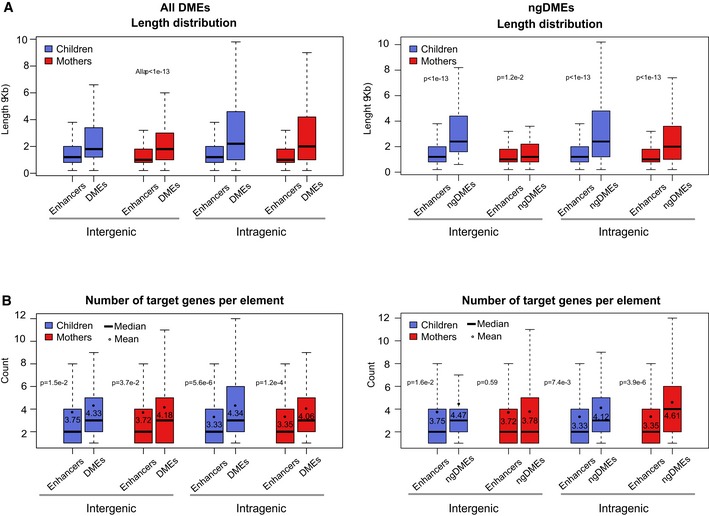
- Length distribution of enhancers (non‐TSS‐associated active regulatory regions) and ngDMEs in mothers and children, both inter‐ and intragenic, indicating a significant increase in length for differentially methylated enhancers compared to other enhancers.
- Distribution of the number of predicted target genes from the interaction datasets for the same categories as in (A). Black dots indicate the mean number. The corresponding P‐value is indicated (Mann–Whitney test), showing a significant increase for ngDMEs, which is more pronounced in intragenic elements.
Data information: (A, B) Box plots vizualize 25/75 percentile and median, whiskers represent non‐outlier range.
Transcriptional response of epigenetic reprogramming of regulatory genomic elements
We next set out to understand whether environmentally associated epigenetic changes would be reflected by differential expression between the smoking and non‐smoking groups in mothers and their children. Therefore, we performed RNA‐seq analysis for 15 mothers and 12 children at time of birth, for which we already had WGBS data (Fig EV1 for sample overview). When calling differentially expressed genes genome wide, we identified only a very small number (< 10 for children, data not shown) of differentially expressed genes after correction for multiple testing (10% FDR, BH correction). To better capture subtle changes of gene expression when comparing groups of healthy individuals, we sought to first understand which pathways are enriched for genes targeted by differentially methylated regions and then to focus our analysis on genes in those pathways. Given the enrichment of DMRs in active enhancers and active promoter regions described in the previous section, we decided to focus on the subset of DMRs, which intersect these active chromatin elements.
To identify target genes of DMRs, we used various datasets from genomic interactions based on ChIA‐PET assays or predicted DHS–promoter interactions (see Appendix Supplementary Methods for details and Table EV3 for assigned genes). Among the pathways significantly enriched in both mothers and children, we identified the WNT signaling pathway (Table EV6). We found 62 genes belonging to the WNT signaling pathway, which are targets of DMRs in smoking mothers and 48 of such genes in their newborn children (Table EV6, Fig EV6). Aberrant WNT signaling has been reported to be involved in the airway inflammatory response in healthy smokers and smokers with chronic obstructive pulmonary disease (COPD) (Wang et al, 2011) and has also been implicated in a variety of tumors, including lung cancer (Ying & Tao, 2009). About half of the pathways enriched by genes targeted by regions that are differentially methylated between the smoking and non‐smoking groups overlapped between children and mothers (Table EV6A). In contrast, the vast majority of pathways enriched for target genes of ngDMRs were different for mothers and their children (Table EV6B) indicating a clear difference in environmental modulation of DNA methylation patterns in mothers and children.
Figure EV6. Perturbation of the WNT signaling pathway.

Shown are modified outputs of the KEGG Mapper tool (v2.1, April 2014) of the WNT signaling pathway for DMRs identified in mothers and children during pregnancy and at time of birth, respectively. Each DMR assigned to a gene of this pathway is indicated in blue for children or red for mothers. The lighter hues correspond to hypomethylation, while the darker hues indicate hypermethylation. Green stars denote DMRs classified as ngDMRs.
About a quarter (n = 22) of all pathways enriched for differential DNA methylation displayed differential expression for the genes in those pathways for mothers or children (Fig EV7A). Among all pathways enriched for DMRs, the WNT pathway in children, but not in mothers, was the pathway with the highest level of significance of differential expression (Fig EV7A). Accordingly, differential expression of genes in the WNT signaling pathway resulted in a clear separation between tobacco smoke‐exposed/non‐exposed samples (Fig EV7B).
Figure EV7. Differential methylation impacts the expression of downstream pathways.
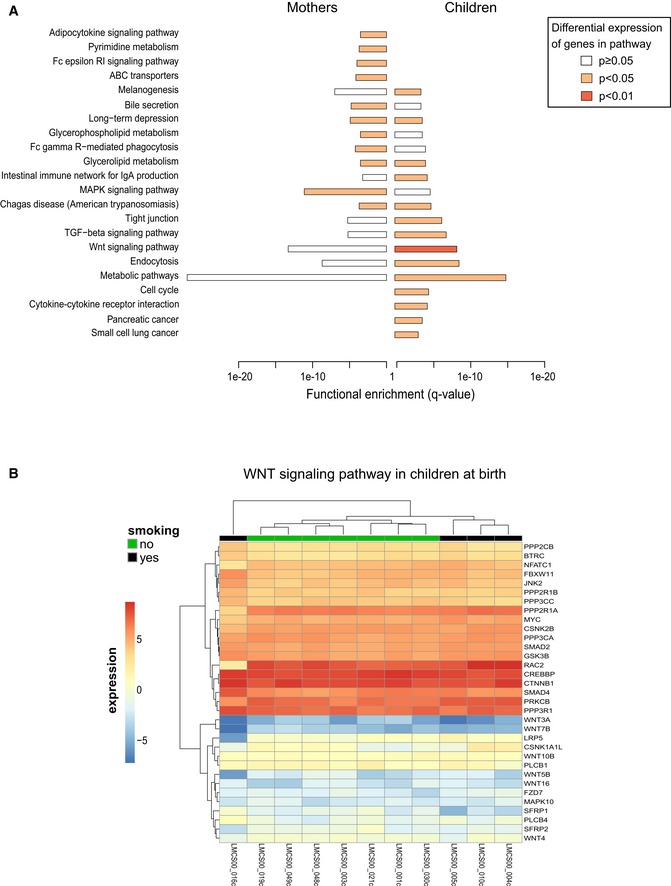
- The bar plot shows the list of pathways that are significantly enriched among the target genes of DMRs intersecting active enhancers and promoters both in mothers and in children (enrichment q‐value indicated on x‐axis) and that show differential expression of genes between smoking and non‐smoking samples as measured by RNA‐seq in either children or mothers. Color of bars indicates significance of differential expression of genes in this pathway (see Appendix Supplementary Methods for details of the calculation). Note that the WNT pathway shows the strongest differential expression in children.
- WNT signaling genes interacting with differentially methylated enhancers (DMEs) show clustering of smokers versus non‐smokers from the RNA expression profile (DME target prediction was mapped by ChiA‐PET where available and nearest TSS otherwise).
More generally, we explored the functional importance of genomic regulatory elements by correlating the DNA methylation level of such elements with transcription of their predicted target genes. In general, correlation between promoter DNA methylation and gene expression was poor and typically only 5–10% of DMRs correlated with gene expression, similar to the observation in a study of chronic lymphocytic leukemia patients (Kulis et al, 2012). Within our dataset, also a relatively weak correlation (6–11%) between DNA methylation and transcription in regions void of any chromatin mark in both mothers and children was observed (Fig EV8A). However, we found a high number of predicted target genes whose expression correlated with DNA methylation in regulatory elements. Almost 30% of all differentially methylated repressive regulatory elements showed a positive correlation with expression of target genes in mothers and 15% in newborn children (Fig EV8B). Note that the same tendency is observed when restricting our analysis to ngDMRs (Fig EV8C). On the other hand, 20% of all differentially methylated enhancers were negatively correlated with expression of target genes in mothers and 8% in newborn children (Fig EV8C). We compared these numbers with the proportion of significant correlations for DMRs within non‐annotated chromatin regions (“void state”), which we considered as background levels, and found that these were indeed much lower. Interestingly, the degree of correlation was much lower at promoters and just above background (“void state”, Fig EV8B and C). This is in line with recent observations that enhancer methylation is a better predictor of gene expression than promoter methylation (Aran et al, 2013; Blattler et al, 2014). For children, we observe fewer significant correlations between methylation in any of these categories, likely reflecting the fact that epigenetic changes in newborns at time of birth translate on the transcriptional status only later in life. Repeating the correlation analysis 1 year after birth for children largely increased the degree of correlation compared to time of birth (Fig EV8A), suggesting that environmentally associated DNA methylation in children was already present at time of birth with increasing impact on transcription in target genes later in life. Taken together, our integrated analysis of genome‐wide DNA methylation, histone modification, and RNA expression identifies enhancers and repressive elements outside TSS, whose differential methylation displays a pronounced correlation with the expression of a large proportion of target genes.
Figure EV8. Correlation of differential methylation and transcription in regulatory elements.
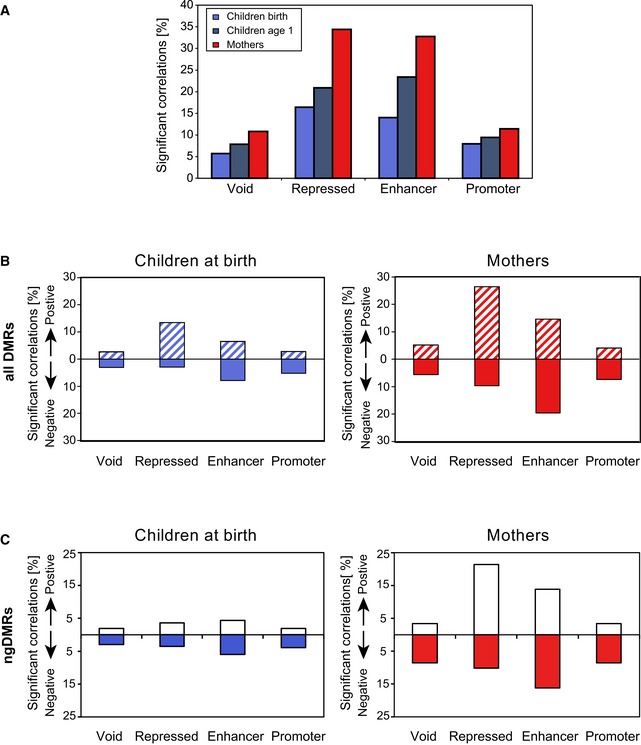
- Proportion of DMR‐target gene pairs showing a significant correlation (Spearman's correlation test p < 0.05) between mean methylation and target gene expression, indicating a higher correlation level for DMRs in repressed or enhancer regions as compared to void or promoter regions. Also, correlation levels increase for children from year 0 to year 1 indicating a temporal gap between epigenetic changes and induced gene expression.
- Proportion of significantly correlated DMR‐target gene pairs in the same categories as (A), split into positive/negative correlation, showing an excess of positive correlation for DMRs associated with repressed regions (containing one or both PRC‐associated H3K27me3 marks as well as the repressive H3K9me3 marks), and an excess of negative correlations for active regions (enhancers and promoters).
- Proportion of significantly correlated ngDMR‐target gene pairs split into positive/negative correlation in the same categories as (B).
Validation of tobacco smoke exposure‐related differential methylation in the entire cohort
Based on our analysis of epigenetically deregulated enhancers, we selected one ngDMR and one gDMR that showed interactions with more than one target gene (commuting enhancer) to confirm the differential DNA methylation observed in the 8 versus 8 comparison in the entire LINA cohort (n = 471, Fig EV1) by MassARRAY‐based targeted DNA methylation analysis. As a representative example of a ngDMR in a commuting enhancer region, we chose the ngDMR with highest significance level when comparing children from smoking to non‐smoking mothers, which was located in an intron of TMEM241 (transmembrane protein 241, Fig 6A). The hypermethylated ngDMR identified in the cord blood was confirmed in the larger sample set. Concomitant with an increase in maternal urine cotinine concentrations, DNA methylation levels increase in this region (Fig 6B). Comparison between WGBS and MassARRAY suggests that the relatively small effects size observed in the targeted validation analysis is related to the weaker spread in methylation values obtained by MassARRAY (Fig 6C).
Figure 6. Validation of two representative examples of commuting enhancers.
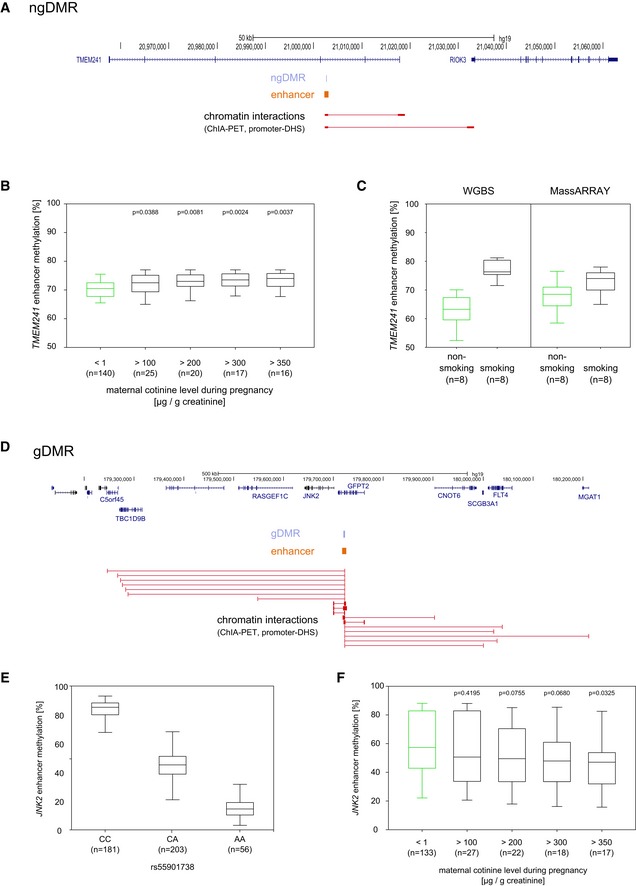
- Extended locus of a commuting enhancer overlapping a ngDMR in the TMEM241 intron.
- The hypermethylated DMR in the enhancer region identified in the cord blood of prenatally exposed children was confirmed by MassARRAY (n = 471). The results show that concomitant with an increase in maternal cotinine levels, DNA methylation increases in this region.
- Box plots compare methylation in the TMEM241 DMR evaluated by WGBS and by MassARRAY, respectively, for the same eight individuals. This comparison suggests that the relatively small effects size observed in the MassARRAY validation seems to be in part related to the weaker spread in methylation values obtained by this method.
- Extended locus of the JNK2 enhancer, showing all predicted target genes by ChIA‐PET and promoter‐DHS interaction data.
- A clear negative correlation between the genotype of rs55901738 (located inside the JNK2 DME) and the methylation level in this locus was observed in the discovery cohort (N = 181/203/56).
- The hypomethylated gDMR within the JNK2 enhancer region was similarly validated by MassARRAY in the entire cohort. Loss of DNA methylation in this region depends on maternal urine cotinine levels and decreases steadily with an increase in maternal urine cotinine concentrations. For children of heavy smoking mothers (cotinine level > 350 ?g/g creatinine) we observe a methylation difference of over 10% compared to non‐smoking mothers.
Data information: (B, C, E, F) Box plots visualize 25th to 75th percentile, line indicates the median, whiskers represent the non‐outlier range.
For the validation of a genetically influenced gDMR, we selected a commuting enhancer involved in WNT signaling and early inflammatory response. This commuting enhancer located in the intron of GFPT2 (glutamine‐fructose‐6‐phosphate transaminase 2) was previously annotated by ChIA‐PET (Li et al, 2012) as an intronic enhancer interacting with a large number of target genes including c‐Jun N‐terminal kinase 2 (JNK2; also known as MAPK9) (Fig 6D). Further inspection of SNPs in a ± 5‐kb window of the “JNK2 commuting enhancer” revealed that the DNA methylation level was correlated with SNP rs55901738 located within this DMR (Fig EV9A). This C>A polymorphism is interesting since it does not occur in a CpG context, which would result in direct loss of DNA methylation. Rather, this polymorphism is predicted to create a new binding site for the transcription factor Oct4. According to our RNA sequence data, Oct4 is expressed in both children and mothers in our cohort. Since the presence of an Oct4 binding site was related to hypomethylation (Zimmerman et al, 2013), the presence of such a binding site may contribute to the decrease of DNA methylation in individuals with the C>A genotype. In both the LINA discovery cohort (Fig 6E) and the LISA validation cohort (Fig EV9B), DNA methylation of the JNK2 commuting enhancer correlates with the genotype. Notably, the majority of children of smoking mothers in the LINA discovery cohort and of tobacco smoke‐exposed children in the LISA validation cohort display a C/A or A/A genotype in this position giving rise to an overall reduced methylation of the JNK2 commuting enhancer in smoking individuals (significant for maternal cotinine level > 350 μg/g creatinine and for children's urine cotinine levels > 40 μg/g creatinine; Table EV9A/B).
Figure EV9. Genotype and tobacco smoke exposure influence methylation of the JNK2 commuting enhancer.
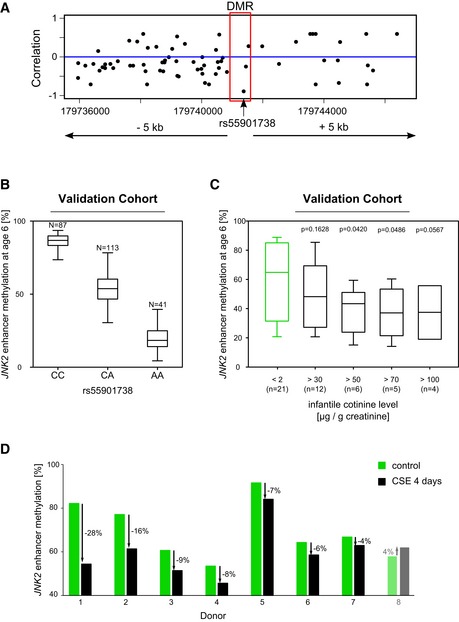
- Locus around the JNK2 DMR showing for each genotyped SNP the correlation of the genotype to the methylation in the DMR region.
- Genotype at the SNP rs55901738 located inside the DME in the validation cohort (N = 87/113/41) indicating a clear negative correlation between the genotype and the methylation level at this locus.
- In an independent validation cohort, we confirmed in six‐year‐old children that cigarette smoke exposure (passive smoking) leads to a decrease of methylation in the JNK2 enhancer region. Children's urine cotinine levels inversely correlate with the JNK2 enhancer methylation level.
- Bar plots showing the loss of DNA methylation in the JNK2 enhancer region following a four‐day treatment of PBMCs with cigarette smoke extract in 8 different donors.
Data information: (B, C) Box plots vizualize 25/75 percentile and median, whiskers represent non‐outlier range.
In cord blood, a decrease of DNA methylation in the JNK2 enhancer was observed that was related to maternal urine cotinine levels (Fig 6F). This relation points to a combined effect with the genotype predisposing for an environmentally triggered epigenetic deregulation of JNK2. This hypothesis is corroborated by our findings that in the LISA cohort, the urine cotinine levels in children also reversely correlated with JNK2 enhancer methylation (Fig EV9C). To test whether DNA demethylation of the JNK2 enhancer is causatively related to tobacco smoke exposure, we applied an in vitro model based on peripheral blood mononuclear cells (PBMCs). Following a four‐day exposure period with a cigarette smoke extract, we observed a decrease in enhancer methylation of 11.1% ± 7.6% (SD) in seven out of eight donors tested, an effect comparable to the reduction in DNA methylation in relation to urine cotinine levels (Fig EV9D).
Link between “commuting enhancer” deregulation and phenotype development
Finally, we aimed to elucidate whether differential DNA methylation in commuting enhancers was linked to a phenotype in the children. Since the function of TMEM241 is yet unknown, we focused this follow‐up analysis on the JNK2 enhancer region. JNK2 is a member of the WNT signaling cascade, which has been implicated in a variety of tobacco smoke‐induced lung diseases including COPD and lung cancer (Ying & Tao, 2009; Wang et al, 2011). Therefore, deregulation in the JNK2 enhancer might contribute to the development of adverse respiratory symptoms, although a link between lung disease development and JNK2 has not yet been described. Maternal smoking during pregnancy has been described as one of the contributing factors of impaired lung function and an increased risk of asthma and wheeze development in children (Burke et al, 2012). Wheezing, a whistling sound produced in the airways during breathing, is widely recognized as an early indicator of such an impaired lung function affecting a considerable number of children already in the first years of life. About 22–46% of children showing wheezing symptoms in early childhood are diagnosed with asthma later in life (Martinez et al, 1995).
We observed a hypomethylation in the JNK2 enhancer region related to tobacco smoke exposure in both mothers and newborn children (Table EV3). Additionally, histone modifications in this enhancer were also clearly linked to the smoking status. While in non‐smoking mothers and their children a repressed or void chromatin state was present, smoking was associated with an active chromatin state in this region (Fig EV10A). In contrast, histone modifications in the promoter of JNK2 were indicative of an active state in all samples irrespective of their smoking status.
Figure EV10. Example of the commuting JNK2 enhancer located in an intron of GFPT2.
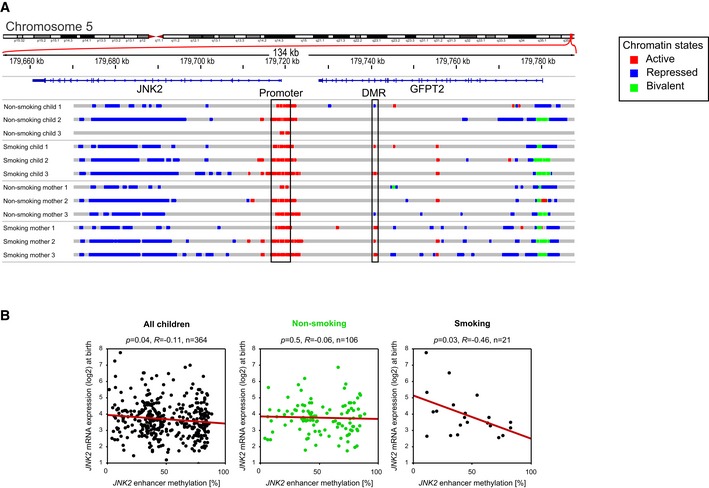
- Chromatin state comparison between non‐smoking/smoking mothers and their children reveals a differentially active region in the intron of GFPT2, which corresponds to a hypomethylated gDMR in the smoking samples.
- Methylation of this region significantly, although weakly, correlates with gene expression of JNK2 (n = 364). Considering children from non‐smoking (urine cotinine [μg]/creatinine [g] < 1, n = 106) or smoking mothers (urine cotinine [μg]/creatinine [g] > 100, n = 21) separately reveals that a significant correlation of methylation and JNK2 transcription is observed only for children of smoking mothers corresponding to the differentially active characteristics of this region.
To further characterize the functional consequences of DNA hypomethylation in this enhancer region, we evaluated its association with JNK2 transcription. DNA methylation and transcription correlated slightly but significantly in the entire cohort already at time of birth (R = −0.11, P = 0.044). Separating children from non‐smoking (R = −0.06, P = 0.56) and smoking (R = −0.46, P = 0.034) mothers revealed that the overall significance was driven by the small subpopulation of children from smoking mothers (Fig EV10B) further supporting a combined effect of genotype and environment in transcriptional regulation of JNK2. In four‐year‐old children, the transcription of JNK2 is again slightly but significantly correlated with JNK2 enhancer methylation (R = −0.16, P = 0.04). Furthermore, blood levels of the pro‐inflammatory cytokine IL‐8, a downstream target of JNK2, correlated with JNK2 expression (Fig EV11A and B) (Holtmann et al, 1999; Hoffmann et al, 2002). Moreover, JNK2 transcription as well as IL‐8 protein expression was significantly elevated in children developing wheezing symptoms from year four on compared to those who never showed any wheezing or other respiratory symptoms (Fig EV11B).
Figure EV11. JNK2 deregulation and perturbed IL‐8 secretion in wheezing children.
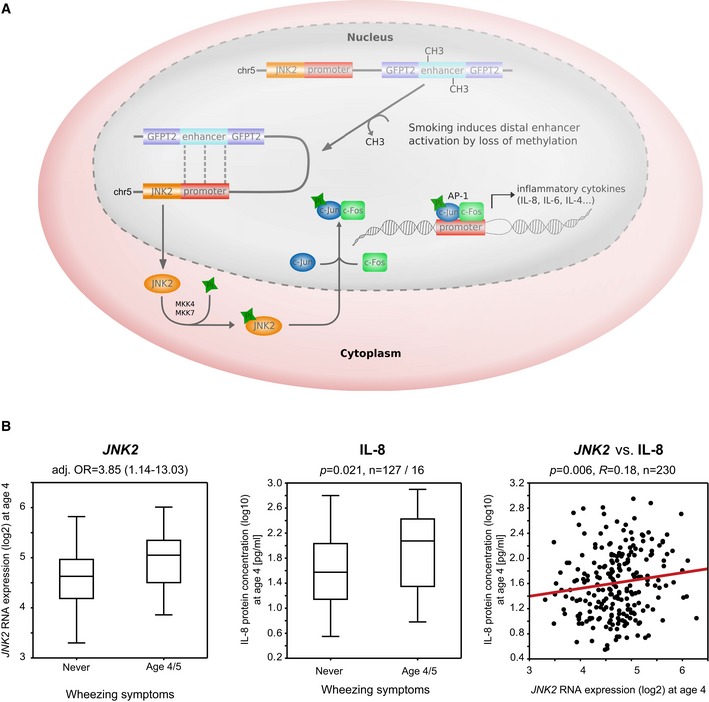
- Loss of methylation in the differentially active JNK2 enhancer might contribute to differential JNK2 expression and altered secretion of the cytokine IL‐8. JNK2 as a mediator of the early inflammatory response phosphorylates the transcription factor c‐Jun that subsequently binds c‐Fos, thereby forming the DNA‐binding complex AP‐1 (activator protein 1). AP‐1 binding motifs have been identified in the promoter region of many cyto‐ and chemokines with IL‐8 being one central downstream target.
- At age four, JNK2 gene expression and IL‐8 protein concentration (measured in serum) are significantly elevated in wheezing children compared to those without any wheezing or other respiratory symptoms (Mann–Whitney test, P = 0.037 and 0.021, respectively). Both expression patterns correlate significantly in the entire cohort (Spearman's correlation p = 0.006, box plots vizualize 25/75 percentile and median, whiskers represent non‐outlier range).
Similar to what we observed when comparing children of smoking and non‐smoking mothers, children developing wheezing symptoms after the age of four (late‐onset wheeze) show a DNA hypomethylation of the JNK2 enhancer. The association between JNK2 enhancer DNA demethylation and late‐onset wheeze was apparent already at birth (ΔMethylation = −17%) and remained stable until the age of four (ΔMethylation = −14%) (Fig 7A). To control for possible confounding factors influencing the risk of wheeze (gender, number of siblings, the presence of a cat in the household, parental history of atopy, smoking during pregnancy, and school education), we performed a logistic regression analysis. These results confirmed that DNA hypomethylation in the JNK2 enhancer region was significantly associated with a higher risk of wheeze (Fig 7A). The resulting odds ratio (OR) of 1.40 implicates a risk increase of 40% per 10% methylation loss. Thus, children with full loss of methylation in this region at time of birth would have an almost 400% increase in risk to develop wheezing symptoms later in life. In the independent validation cohort (LISA), we confirmed that loss of DNA methylation in the JNK2 enhancer is associated with an increased risk for the development of wheezing symptoms in four‐year‐old children with an adjusted OR of 1.48 (CI:1.07–2.05; Fig 7A).
Figure 7. JNK2 is linked to lung disease.
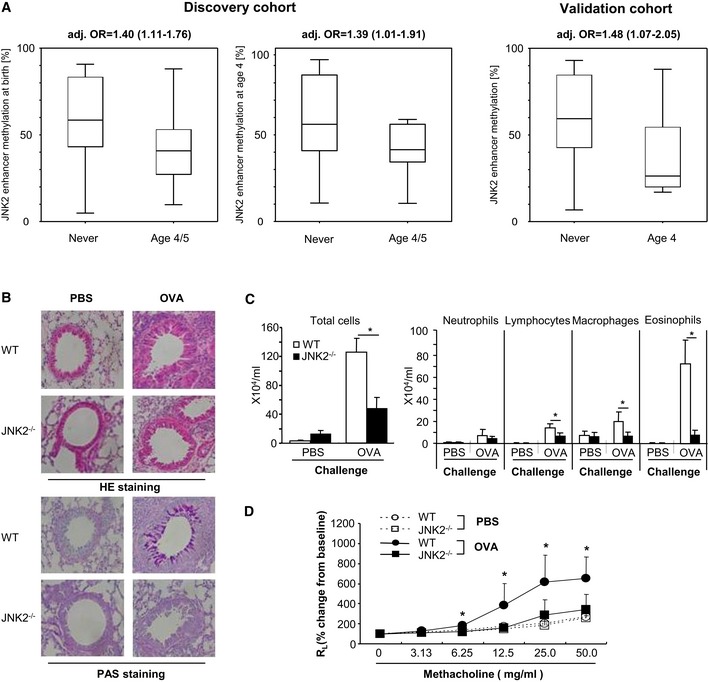
-
AIn both the discovery and the validation cohort, we show that loss of DNA methylation in the JNK2 enhancer is associated with an increased risk for the development of wheezing symptoms in four‐year‐old children. Odds ratios are calculated using logistic regression models adjusted for gender, number of siblings, the presence of a cat in the household, parental history of atopy, school education, and smoking during pregnancy (adj. OR). In 4‐year‐old children, regression models were additionally adjusted for postnatal smoking (infantile urine cotinine concentrations, box plots vizualize 25/75 percentile and median, whiskers represent non‐outlier range).
-
B–DJNK2 knockdown leads to a diminished asthma response in OVA‐sensitized mice. (B) HE‐ and PAS‐stained lung sections of OVA‐sensitized JNK2−/− mice show reduced cell infiltration and mucous gland hyperplasia compared to wild‐type controls. (C) The number of eosinophils, lymphocytes, and macrophages in BAL fluid is significantly lower in JNK2−/− mice, (D) which is accompanied by a decrease in AHR compared to OVA‐sensitized WT mice (*P < 0.05 by Student's t‐test, data are shown as mean ± SD (n = 10–15) of three independent experiments).
To further assess the role of JNK2 in the development of lung disease, we investigated the effect of JNK2 deficiency in a mouse asthma model. Sensitization and challenge of JNK2−/− mice with ovalbumin (OVA) resulted in markedly reduced airway inflammation shown by substantially less inflammatory infiltrates in the peribronchial and perivascular regions and a decreased mucous gland hyperplasia in the airway epithelium compared to OVA‐sensitized wild‐type (WT) animals (Fig 7B). Accordingly, the accumulation of eosinophils, lymphocytes, and macrophages in the bronchoalveolar lavage (BAL) fluid of JNK2−/− mice was clearly diminished (Fig 7C). Furthermore, the methacholine‐induced airway hyperreactivity (AHR), measured as lung resistance (RL), was significantly reduced in JNK2−/− mice compared to WT controls (Fig 7D). Therefore, JNK2 deficiency leads to a diminished asthma phenotype, which supports the findings in our cohort confirming that JNK2 is directly involved in the development of lung disease. Taken together, we link loss of DNA methylation in the JNK2 commuting enhancer with the occurrence of impaired lung function mediated through differential expression of its target gene JNK2, a thus far unknown key player in the development of lung disease.
Discussion
How prenatal exposure to smoking and other factors affect the newborn's epigenome and to which extent the resulting changes are stably maintained has been a central question for epigenetic medical research. Here, we acquired comprehensive genome‐wide maps of DNA methylation changes linked to smoking and combined them with histone modification profiles and gene expression analysis. This represents an entirely different approach compared to previous EWAS focusing exclusively on methylation changes of a smaller subset of all CpGs genome wide. We demonstrated for the first time within a longitudinal human cohort study that in utero exposure to tobacco smoke affects the global epigenome of both mothers and children in regulatory elements and that this epigenetic modulation is stably maintained. Interestingly, while the unborn child is exposed to similar environmental challenges as its mother, the response on the DNA methylation and histone modification level is quite distinct. Apart from potential age‐related epigenetic pattern, this could be due to the specificity of the placental barrier, which potentially leads to higher exposure of the unborn child to components of tobacco smoke as nicotine than the mother (Luck et al, 1985).
DNA methylation and enhancer activity are linked as demonstrated in a number of studies (Aran & Hellman, 2013),(Hon et al, 2013; Mukamel & Tanay, 2013). Notably, a preference of tissue specific DMRs at distal cis‐regulatory elements was reported with some of these enhancers being dormant in adult tissues but active during embryonic development (Hon et al, 2013). The mechanistic details of the cross talk between DNA methylation, histone modifications, and enhancer RNA transcription are currently unclear but might involve links between DNA and histone modifications (Bergman & Cedar, 2013) as well as modulation of transcription factor binding due to DNA (hydroxy)methylation‐directed nucleosome positioning (Teif et al, 2014). It should be noted that our results on the functional relevance of deregulated epigenetic signaling at intragenic enhancers and its link to disease risk could only be obtained from individualized epigenome annotations in addition to cell line‐derived maps like histone modification ChIP‐seq and DNase I hypersensitivity data from consortia like ENCODE or Roadmap.
Prenatal tobacco smoke exposure has been identified as one of the important risk factors for impaired lung function later in children's life. Accordingly, we specifically focused on potential links between DNA methylation changes and the development of respiratory diseases in children. Supported by our in vitro results, our epidemiological data indicate a combined impact of tobacco smoke and the genotype on DNA methylation of the JNK2 commuting enhancer located in the GFPT2 gene and show that DNA methylation loss and gain of activating histone marks within this commuting enhancer correlates with an increase of JNK2 gene expression. Loss of DNA methylation in the JNK2 enhancer was furthermore associated with an increased risk for children to develop wheezing symptoms later in their life. A mouse asthma model corroborated the functional relevance of our epigenome analysis. The JNK2−/− mice exhibited markedly reduced airway inflammation and airway hyperreactivity compared to WT controls suggesting a direct role for JNK2 in the development of lung disease. Further evidence for the regulatory role of JNK2 comes from a recent study demonstrating enhanced airway inflammation and impaired lung function due to a JNK2‐triggered loss of the regulatory function of naturally occurring regulatory T cells (Joetham et al, 2014). Regulatory T cells were identified as important regulators of allergic lung diseases as they are recruited from the blood to allergen‐challenged lungs inhibiting asthmatic responses. Since cross talk between activated immune cells from the blood and lung tissue was shown to contribute to the development and exacerbation of the local inflammatory response in the lung tissue (O'Donnell et al, 2006), changes of JNK2 activity in blood cells are likely to reflect corresponding changes in cells infiltrating inflamed lung tissue.
For the first time, we distinguished between genotype‐ and environment‐related effects on the epigenome in a genome‐wide approach. We showed that in both mothers and children, a significant proportion of the DMRs appear to be driven by nearby genotype effects (7005/8409 in children, 7790/9743 in mothers). However, this also means that around 20% of the DMRs are not affected by nearby SNPs, and might be the result of environmental exposure to tobacco smoke. Interestingly, the enrichment of this set of ngDMRs in enhancers is considerably more significant than the enrichment seen by considering all DMRs, indicating that ngDMRs indeed represent a separate class of elements. We also showed that differential methylation in annotated chromatin regions has an effect on gene expression, depending on the type of chromatin marks present in the locus. In particular, differential methylation in enhancer regions correlates negatively with expression, more than in promoter regions or in void regions. Hence, modulation of the enhancer activity through variable DNA methylation conditioned by non‐genotype effects leads to a differential regulation of downstream genes (Aran et al, 2013; Blattler et al, 2014). The fact that enhancers overlapping with DMRs have more target genes compared to the full set of enhancers indicates that differential methylation is targeted at regulatory hubs. While histone modifications might also be under the control of the genotype (Kasowski et al, 2013; Kilpinen et al, 2013; McVicker et al, 2013), our focus was specifically on alterations in the DNA methylation pattern.
Although we focused our validation experiments on enhancer regions overlapping with DMRs, we do not claim that only epigenetic deregulation in enhancer regions are of biological relevance. We decided to focus on enhancers to emphasize the fact that regulatory regions are more frequently epigenetically deregulated by tobacco smoke exposure than other genomic regions. However, DMRs in other genomic regions could potentially also be related to a particular phenotype by enhancer‐independent mechanism. A prominent example is the hypomethylated cg19859270 in the GPR15 gene body found in active and former smokers with a delta methylation of only 1–2%. As we showed in a previous study (Bauer et al, 2015), this very minor methylation change, identified in whole blood DNA samples, is related to the expansion of a small subset of GPR15 expressing T cells potentially involved in lung inflammation. This example shows that even very minor methylation changes observed in whole blood samples might be of strong biological relevance.
Non‐genetically associated differential DNA methylation was shown to be faithfully conserved over years in children's life. In the LINA cohort, only a relatively small number of children were exposed to tobacco smoke prenatally but not after birth. In many instances, however, children prenatally exposed to tobacco smoke remain exposed after birth. Accordingly, it was difficult to evaluate whether persistence of this environmental exposure after birth, albeit at a largely reduced effective concentration, could contribute to the high stability of induced DNA methylation changes in children over years after birth. Another important question is if other maternally or paternally transferred environmental challenges such as psychological stress, pollutants, and nutrition that are also monitored as part of the LINA study would have synergistic or independent effects on the children's epigenome. Thus, we anticipate that further exciting links between environmental factors and epigenetic deregulation will be revealed from the LINA dataset in continuation of the approach introduced here.
Apparently, the design of our study differs from conventional EWAS starting with a large sample set but focusing solely on DNA methylation changes in preselected CpG sites covering at best 5% of the genome. Although our WGBS approach was based initially only on 8 versus 8 mother–child pairs, we were able to confirm differential methylation at single CpG sites identified in those large EWAS (e.g., AHRR cg05575921, ΔMethylation = −9.8%, P‐value=0.007; MYO1G cg12803068, ΔMethylation = 12.1%, P‐value = 0.038; GFI1 cg18146737, ΔMethylation = −16.9%, P‐value = 0.05). Even though WGBS is not yet feasible for larger cohorts with hundreds or thousands of individuals, results obtained on a smaller sample set are representative as shown in the validation analysis (TMEM241 and JNK2 enhancer). The major advantage of this WGBS‐based approach is the opportunity to study important genomic regions beyond promoters largely covered by DNA methylation arrays. Note that regulatory elements in particular enhancers are largely missing on these commonly used arrays. Thus, we were able to show for the first time that environmental exposure deregulates particularly regulatory regions of the genome. Moreover, by combining DNA methylation, histone modification, and gene expression analyses, we showed that epigenetic perturbation by environmental exposure is functionally translated and potentially linked to phenotype development. Thus, the depth and breadth of our analyses goes well beyond any earlier environmental epigenetics study.
Materials and Methods
Description of the cohorts
For this study, two population‐based cohorts were employed. As discovery cohort, we used the prospective mother–child cohort, LINA (Lifestyle and environmental factors and their Influence on Newborns Allergy risk). For this cohort, 629 mother–child pairs (622 mothers and 629 children; seven twins) were recruited between May 2006 and December 2008 in Leipzig, Germany, to investigate the pre‐ and postnatal influences of lifestyle and environmental factors on the immune system of the newborn and the disease risk of the child later in life. Mothers suffering from immune or infectious diseases during pregnancy were excluded from the study. Blood samples were obtained from mothers at the 36th week of gestation and cord blood at delivery (for details see Herberth et al, 2010, 2011). Longitudinal blood samples at year one till five were taken from both children and mothers (Fig EV1). During pregnancy, standardized questionnaires were recorded, as well as at each child's birthday (see Appendix Supplementary Methods). All questionnaires were self‐administered by the parents. Maternal smoking was determined based on the questionnaire response and urine cotinine levels > 100 μg/g creatinine (see Appendix Supplementary Methods). During annual clinical visits, blood samples were obtained from children and mothers. Participation in the study was voluntary, and informed consent was obtained from all participants. The study was approved by the Ethics Committees of the University of Leipzig (046‐2006, 160‐2008, 160b/2008, 144‐10‐31052010, 113‐11‐18042011).
As validation cohort, we used a further prospective birth cohort, LISA (Life style–Immune System–Allergy). For LISA, a total of 2443 healthy neonates born in the German cities Munich and Leipzig were recruited between December 1997 and January 1999. The study design, blood sampling, and the questionnaire items used for the description of children's disease outcomes and confounding variables were comparable between LINA and LISA (Lehmann et al, 2002). The study was approved by the Ethics Committees of the University of Leipzig and Munich (206/2003). Written informed consent was obtained from the parents of all children.
Whole‐genome bisulfite sequencing
Whole blood samples were obtained from eight smoking and eight non‐smoking mother–child pairs (see Appendix Supplementary Methods and Fig EV1). Libraries were prepared using the TruSeq DNA Sample Prep Kit v2‐Set A (Illumina Inc., San Diego, CA, USA) according to the manufacturer's instructions. Adapter‐ligated libraries were treated with bisulfite and PCR‐amplified (see Appendix Supplementary Methods and Table EV10). Sequencing on HiSeq2000 (101‐bp paired‐end) was performed using standard Illumina protocols and the 200‐cycle TruSeq SBS Kit v3 (Illumina Inc., San Diego, CA, USA).
DMR calling and annotation
The bsseq v0.10 package (Hansen et al, 2012) for R statistical software v3.0.0 was used to smooth bisulfite sequencing data and call candidate DMRs. Because of our high average CpG coverage, we performed smoothing on a small window size with minimum 11 CpGs (ns = 11) and a minimum total width of 1 kb (h = 500), breaking the smoothing if gaps between CpGs exceeded 2 kb (maxGap = 2000). We calculated average raw methylation levels of each DMR and sample and performed a moderated t‐test as in SAM statistics (significance analysis of microarrays, Tusher et al, 2001; R‐package siggenes v1.36.0, Schwender, 2012) to assign P‐values to each of the DMR. SAM P‐values are low for DMRs that are consistently different between the groups. Based on the P‐value (pSAM < 0.1) and the level of mean methylation changes (∆Methylation > 0.1 in both raw and smoothed data), we filtered and ranked the DMR list for downstream analyses. We conducted false discovery rate analysis (FDR) based on permutation analysis of DMRs before and after SAM filtering with thresholds for ∆Methylation (1–25%). The obtained results suggest that a cutoff of 10% offers an optimal balance between high sensitivity and medium specificity, which is required when comparing groups of healthy individuals (see Appendix Supplementary Methods).
Initial genomic annotation of DMRs to the nearest TSS was obtained with the annotate Peaks script of the HOMER tools software package (Heinz et al, 2010) to genome version hg19. For calculating the significance of enrichment of DMRs in certain regions of interest (ROIs), we performed a random shuffling approach. First, regions of the same size as the DMRs were randomly sampled from the whole genome. In a second step, the number of overlaps of these random regions with the ROIs was calculated using BEDTools (Quinlan & Hall, 2010). This procedure was repeated 1000 times to determine the empirical null distribution. This empirical distribution was used to estimate the one‐sided upper‐tail P‐values for enrichment. We calculated the fold change as the number of overlaps of the DMRs with the ROIs divided by the average number as determined by the randomizations.
ChIP‐seq assays and peak calling
ChIP‐seq of histone modifications was performed in six mother–child pairs including three smoking and three non‐smoking mothers and their children using standard ChIP‐seq protocols (see Appendix Supplementary Methods). Regions of the genome exhibiting significant enrichment of histone modifications were identified using SICER v1.3 (Zang et al, 2009) and MACS v 1.4.1 (Zhang et al, 2008). Reads were aligned as outlined by Feng et al (2012). MACS was used to call peaks setting the histone modification alignment file as the treatment and the H3 SAM file as the control files. A threshold of P ≤ 1e‐5 was used to identify significant peaks. Additional peaks were called using SICER on all histone modifications with H3 as a control, removing all duplicate reads. The MACS and SICER peak calls were merged to maximize sensitivity. The peak calling summary is shown in Table EV1B.
Genome segmentation and chromatin annotation
The chromatin was segmented and annotated using a multivariate Hidden Markov Model, ChromHMM (Ernst & Kellis, 2012). We trained a ChromHMM model over the four histone modification marks (H3K4me1, H3K27ac, H3K27me3, and H3K9me3) across all samples, which was subsequently used to segment the genome of each individual. The model was learned using the merged peak calls from MACS and SICER as the binarized input and allowing for a maximum of 400 iterations. We generated models with 5–16 states and decided to use 16 states as this captures all combinations of the four histone modifications so that rare chromatin states are also represented (Fig 4B). Each chromatin state was labeled based on a biologically interpretable name corresponding to the co‐occurring histone marks. Chromatin states were merged over subsets of the data covering mothers, children, and their smoking and non‐smoking subsets, where at least two samples had a genomic locus labeled to be of a particular chromatin state. To annotate promoter‐associated marks, we identified all features overlapping with a RefSeq TSS, directly neighboring the overlapping feature with the TSS and its direct neighbors, and all features 400 bp from these, and annotated them as “TSS associated”. The remaining was labeled as “not TSS associated”. Active regulatory elements were identified by merging three active states (states 1, 2, and 3, see Fig 4) into a common meta‐state. Active regulatory elements, which were not TSS associated, were defined as enhancers. A repressed meta‐state was defined by merging states 12, 13, and 14.
RNA sequencing and analysis
RNA‐seq libraries were built using the Illumina TruSeq RNA Sample Preparation Kit v2 (Illumina Inc., San Diego, CA, USA) according to the manufacturer's instructions. The final libraries were validated using Qubit (Invitrogen) and Agilent 2100 Bioanalyzer (Agilent Technologies). Sequencing on Illumina HiSeq2000/2500 (101‐bp paired‐end) was performed using standard protocols and the 200‐cycle TruSeq SBS Kit v3 (see Appendix Supplementary Methods). RNA sequences were aligned to hg19 reference genome using the STAR alignment software (Dobin et al, 2013), with Gencode v19 as the transcriptome annotation. Counts of reads mapped to exons were estimated by htseq‐count (Anders et al, 2015). For downstream analysis, raw counts were normalized by the Voom method in the limma package (Smyth, 2005) and the Combat method in the sva package (Jeffrey et al, 2014) was applied to correct for possible batch effects.
Correlation analysis between DMRs and expression of target genes
We calculated the Spearman correlation between the mean DMR methylation and the target gene expression. For DMRs containing multiple CpG sites, mean methylation across CpG sites was calculated per sample. DMRs were first intersected with different chromatin states inferred from ChIP‐seq data. For DMRs overlapping with void or TSS‐associated states, the closest gene was used as the target gene. For DMRs overlapping with repressed or non‐TSS‐associated states, we used the predicted target gene from public interaction datasets (ChIA‐PET and promoter–DHS interactions, see Appendix Supplementary Methods). For DMEs (DMRs overlapping with enhancers), we used the union of the target genes of the DMR and the overlapping enhancer. For each DMR‐target gene pair, the significance of the correlation was calculated by the Spearman correlation test and the cutoff for significance was set to 0.05.
Validation by MassARRAY methylation analysis and qPCR
Quantitative DNA methylation analyses of the enhancers in the TMEM241 and GFPT2 genes was performed using Sequenom's MassARRAY platform. Bisulfite‐treated libraries were PCR‐amplified. The PCR product was in vitro transcribed and cleaved by RNase A using the EpiTyper T Complete Reagent Set (Sequenom, Hamburg, Germany) and subjected to MALDI‐TOF mass spectrometry analysis to determine methylation patterns as previously described (Ehrich et al, 2008). DNA methylation standards (0, 20, 40, 60, 80, and 100% methylated genomic DNA) were used to control for potential PCR bias.
For qPCR, total RNA was prepared from fresh cord blood by using peqGold RNA Pure (peqlab, Erlangen, Germany) and from blood collected in PAXgene Blood RNA Tube of year four by PAXgene Blood RNA Kit (Qiagen, Hilden, Germany), according to manufacturer's instructions. The cDNA synthesis was carried out with 5 μg of RNA by using ImProm‐II™ Reverse Transcription System (Promega, Mannheim, Germany). Gene expression was measured using the 96.96 Dynamic Array or FLEXsix Integrated Fluidic Circuits (IFCs) (Fluidigm, San Francisco, CA, USA). Intron‐spanning primers were designed (see Appendix Supplementary Methods). Gene expression values were determined by using the 2−∆∆CT method (Livak & Schmittgen, 2001) with GAPD and GUSB, as reference genes and normalized to the lowest measured value.
Murine asthma model
JNK21−/− mice (C57BL/6 background) and control wild‐type mice (WT) were bred and maintained at the animal facility of the Tokyo Medical University. Experiments were approved by the Ethical Committee of Animal Experiments of the Tokyo Medical University. JNK2−/− and C57BL/6J WT mice were sensitized and challenged with ovalbumin (OVA) and assayed for airway inflammation and airway hyperreactivity (AHR) as described before (Takada et al, 2013) and in the Appendix Supplementary Methods.
Data availability
Next‐generation sequencing data have been deposited at the European Genome‐phenome Archive (EGA, http://www.ebi.ac.uk/ega/) hosted by the EBI, under accession numbers EGAS00001000455.
Author contributions
MBa, ST, LT, DW, J M, OM MW, GH, MiS, CG, SWi, RE, and IL performed and/or coordinated experimental work. TB, NI, CH, LG, MBi, ZG KG, QW, SR, MBa, GH, ST, MaS, KR, and CL performed data analysis. MBo, SR, GH, UR‐K, KJ, and IL collected data and provided proband materials. ET and JM performed the mouse experiments. TB, ST, NI, MBa, LG, QW, GH, LT, DW, CP, KJ, TP, SR, ZG, KR, C H, RE, and IL prepared the initial manuscript and figures. HS, CP, CH, RE, and IL provided project leadership. All authors contributed to the final manuscript.
Conflict of interest
The authors declare that they have no conflicting interest.
Supporting information
Appendix
Expanded View Figures PDF
Table EV1
Table EV2
Table EV3
Table EV4
Table EV5
Table EV6
Table EV7
Table EV8
Table EV9
Table EV10
Review Process File
Acknowledgements
We would like to thank Stephan Wolf and Nicole Diessl at the DKFZ Genomics and Proteomics Core Facility for the excellent technical support and expertise. Further, we are grateful to Marion Bähr and Monika Helf who provided outstanding support in MassARRAY validation. We acknowledge very helpful discussions of cell lineage markers with Daniel Lipka and Soo‐Zin Kim‐Wanner and critical discussion of the manuscript with Christopher C. Oakes. We cordially thank the participants of the LINA study as well as Beate Fink, Anne Hain, Livia Sztraka, and Melanie Nowak for their excellent technical assistance and fieldwork. We are grateful to Martin von Bergen for providing urine cotinine concentrations. We also thank Pavel Komardin (Data management group at eilslabs) for the organization and implementation of all tasks involved in data submission to EBI. This work was supported by the Helmholtz cross program activity on Personalized Medicine (iMed) and the BMBF‐funded eMED network PANC‐STRAT (FKZ: 01ZX1305A). Major support came from the German Cancer Research Center—Heidelberg Center for Personalized Oncology (DKFZ‐HIPO).
Mol Syst Biol. (2016) 12: 861
References
- Aguilera O, Fernandez AF, Munoz A, Fraga MF (2010) Epigenetics and environment: a complex relationship. J Appl Physiol 109: 243–251 [DOI] [PubMed] [Google Scholar]
- Anders S, Pyl TP, Huber W (2015) HTSeq — a Python framework to work with high‐throughput sequencing data. Bioinformatics 31: 166–169. [DOI] [PMC free article] [PubMed] [Google Scholar]
- Aran D, Hellman A (2013) DNA methylation of transcriptional enhancers and cancer predisposition. Cell 154: 11–13 [DOI] [PubMed] [Google Scholar]
- Aran D, Sabato S, Hellman A (2013) DNA methylation of distal regulatory sites characterizes dysregulation of cancer genes. Genome Biol 14: R21 [DOI] [PMC free article] [PubMed] [Google Scholar]
- Bauer M, Linsel G, Fink B, Offenberg K, Hahn AM, Sack U, Knaack H, Eszlinger M, Herberth G (2015) A varying T cell subtype explains apparent tobacco smoking induced single CpG hypomethylation in whole blood. Clin Epigenetics 7: 1–11 [DOI] [PMC free article] [PubMed] [Google Scholar]
- Bergman Y, Cedar H (2013) DNA methylation dynamics in health and disease. Nat Struct Mol Biol 20: 274–281 [DOI] [PubMed] [Google Scholar]
- Blattler A, Yao L, Witt H, Guo Y, Nicolet CM, Berman BP, Farnham PJ (2014) Global loss of DNA methylation uncovers intronic enhancers in genes showing expression changes. Genome Biol 15: 469 [DOI] [PMC free article] [PubMed] [Google Scholar]
- Breton CV, Byun HM, Wenten M, Pan F, Yang A, Gilliland FD (2009) Prenatal tobacco smoke exposure affects global and gene‐specific DNA methylation. Am J Respir Crit Care Med 180: 462–467 [DOI] [PMC free article] [PubMed] [Google Scholar]
- Brown AS, Susser ES, Lin SP, Neugebauer R, Gorman JM (1995) Increased risk of affective disorders in males after second trimester prenatal exposure to the Dutch hunger winter of 1944–45. Br J Psychiatry 166: 601–606 [DOI] [PubMed] [Google Scholar]
- Burke H, Leonardi‐Bee J, Hashim A, Pine‐Abata H, Chen Y, Cook DG, Britton JR, McKeever TM (2012) Prenatal and passive smoke exposure and incidence of asthma and wheeze: systematic review and meta‐analysis. Pediatrics 129: 735–744 [DOI] [PubMed] [Google Scholar]
- Dobin A, Davis CA, Schlesinger F, Drenkow J, Zaleski C, Jha S, Batut P, Chaisson M, Gingeras TR (2013) STAR: ultrafast universal RNA‐seq aligner. Bioinformatics 29: 15–21 [DOI] [PMC free article] [PubMed] [Google Scholar]
- Ehrich M, Turner J, Gibbs P, Lipton L, Giovanneti M, Cantor C, van den Boom D (2008) Cytosine methylation profiling of cancer cell lines. Proc Natl Acad Sci USA 105: 4844–4849 [DOI] [PMC free article] [PubMed] [Google Scholar]
- Ernst J, Kellis M (2012) ChromHMM: automating chromatin‐state discovery and characterization. Nat Methods 9: 215–216 [DOI] [PMC free article] [PubMed] [Google Scholar]
- Feng J, Liu T, Qin B, Zhang Y, Liu XS (2012) Identifying ChIP‐seq enrichment using MACS. Nat Protoc 7: 1728–1740 [DOI] [PMC free article] [PubMed] [Google Scholar]
- Guida F, Sandanger TM, Castagne R, Campanella G, Polidoro S, Palli D, Krogh V, Tumino R, Sacerdote C, Panico S, Severi G, Kyrtopoulos SA, Georgiadis P, Vermeulen RC, Lund E, Vineis P, Chadeau‐Hyam M (2015) Dynamics of smoking‐induced genome‐wide methylation changes with time since smoking cessation. Hum Mol Genet 24: 2349–2359 [DOI] [PMC free article] [PubMed] [Google Scholar]
- Gutierrez‐Arcelus M, Lappalainen T, Montgomery SB, Buil A, Ongen H, Yurovsky A, Bryois J, Giger T, Romano L, Planchon A, Falconnet E, Bielser D, Gagnebin M, Padioleau I, Borel C, Letourneau A, Makrythanasis P, Guipponi M, Gehrig C, Antonarakis SE et al (2013) Passive and active DNA methylation and the interplay with genetic variation in gene regulation. eLife 2: e00523. [DOI] [PMC free article] [PubMed] [Google Scholar]
- Hansen KD, Langmead B, Irizarry RA (2012) BSmooth: from whole genome bisulfite sequencing reads to differentially methylated regions. Genome Biol 13: R83 [DOI] [PMC free article] [PubMed] [Google Scholar]
- Heinz S, Benner C, Spann N, Bertolino E, Lin YC, Laslo P, Cheng JX, Murre C, Singh H, Glass CK (2010) Simple combinations of lineage‐determining transcription factors prime cis‐regulatory elements required for macrophage and B cell identities. Mol Cell 38: 576–589 [DOI] [PMC free article] [PubMed] [Google Scholar]
- Hemminki K, Chen B (2006) Parental lung cancer as predictor of cancer risks in offspring: clues about multiple routes of harmful influence? Int J Cancer 118: 744–748 [DOI] [PubMed] [Google Scholar]
- Herberth G, Daegelmann C, Weber A, Roder S, Giese T, Kramer U, Schins RP, Behrendt H, Borte M, Lehmann I (2006) Association of neuropeptides with Th1/Th2 balance and allergic sensitization in children. Clin Exp Allergy 36: 1408–1416 [DOI] [PubMed] [Google Scholar]
- Herberth G, Heinrich J, Roder S, Figl A, Weiss M, Diez U, Borte M, Herbarth O, Lehmann I (2010) Reduced IFN‐gamma‐ and enhanced IL‐4‐producing CD4 + cord blood T cells are associated with a higher risk for atopic dermatitis during the first 2 yr of life. Pediatr Allergy Immunol 21: 5–13 [DOI] [PubMed] [Google Scholar]
- Herberth G, Hinz D, Roder S, Schlink U, Sack U, Diez U, Borte M, Lehmann I (2011) Maternal immune status in pregnancy is related to offspring's immune responses and atopy risk. Allergy 66: 1065–1074 [DOI] [PubMed] [Google Scholar]
- Heyn H, Li N, Ferreira HJ, Moran S, Pisano DG, Gomez A, Diez J, Sanchez‐Mut JV, Setien F, Carmona FJ, Puca AA, Sayols S, Pujana MA, Serra‐Musach J, Iglesias‐Platas I, Formiga F, Fernandez AF, Fraga MF, Heath SC, Valencia A et al (2012) Distinct DNA methylomes of newborns and centenarians. Proc Natl Acad Sci USA 109: 10522–10527 [DOI] [PMC free article] [PubMed] [Google Scholar]
- Hoffmann E, Dittrich‐Breiholz O, Holtmann H, Kracht M (2002) Multiple control of interleukin‐8 gene expression. J Leukoc Biol 72: 847–855 [PubMed] [Google Scholar]
- Holtmann H, Winzen R, Holland P, Eickemeier S, Hoffmann E, Wallach D, Malinin NL, Cooper JA, Resch K, Kracht M (1999) Induction of interleukin‐8 synthesis integrates effects on transcription and mRNA degradation from at least three different cytokine‐ or stress‐activated signal transduction pathways. Mol Cell Biol 19: 6742–6753 [DOI] [PMC free article] [PubMed] [Google Scholar]
- Hon GC, Rajagopal N, Shen Y, McCleary DF, Yue F, Dang MD, Ren B (2013) Epigenetic memory at embryonic enhancers identified in DNA methylation maps from adult mouse tissues. Nat Genet 45: 1198–1206 [DOI] [PMC free article] [PubMed] [Google Scholar]
- Jeffrey T, Leek W, Johnson E, Parker HS, Jaffe AE, Storey JD (2014) sva: Surrogate Variable Analysis. R package version 3.8.0
- Joetham A, Schedel M, Takeda K, Jia Y, Ashino S, Dakhama A, Lluis A, Okamoto M, Gelfand EW (2014) JNK2 regulates the functional plasticity of naturally occurring T regulatory cells and the enhancement of lung allergic responses. J Immunol 193: 2238–2247 [DOI] [PMC free article] [PubMed] [Google Scholar]
- Joubert BR, Haberg SE, Nilsen RM, Wang X, Vollset SE, Murphy SK, Huang Z, Hoyo C, Midttun O, Cupul‐Uicab LA, Ueland PM, Wu MC, Nystad W, Bell DA, Peddada SD, London SJ (2012) 450K epigenome‐wide scan identifies differential DNA methylation in newborns related to maternal smoking during pregnancy. Environ Health Perspect 120: 1425–1431 [DOI] [PMC free article] [PubMed] [Google Scholar]
- Kasowski M, Kyriazopoulou‐Panagiotopoulou S, Grubert F, Zaugg JB, Kundaje A, Liu Y, Boyle AP, Zhang QC, Zakharia F, Spacek DV, Li J, Xie D, Olarerin‐George A, Steinmetz LM, Hogenesch JB, Kellis M, Batzoglou S, Snyder M (2013) Extensive variation in chromatin states across humans. Science 342: 750–752 [DOI] [PMC free article] [PubMed] [Google Scholar]
- Kilpinen H, Waszak SM, Gschwind AR, Raghav SK, Witwicki RM, Orioli A, Migliavacca E, Wiederkehr M, Gutierrez‐Arcelus M, Panousis NI, Yurovsky A, Lappalainen T, Romano‐Palumbo L, Planchon A, Bielser D, Bryois J, Padioleau I, Udin G, Thurnheer S, Hacker D et al (2013) Coordinated effects of sequence variation on DNA binding, chromatin structure, and transcription. Science 342: 744–747 [DOI] [PMC free article] [PubMed] [Google Scholar]
- Kulis M, Heath S, Bibikova M, Queiros AC, Navarro A, Clot G, Martinez‐Trillos A, Castellano G, Brun‐Heath I, Pinyol M, Barberan‐Soler S, Papasaikas P, Jares P, Bea S, Rico D, Ecker S, Rubio M, Royo R, Ho V, Klotzle B et al (2012) Epigenomic analysis detects widespread gene‐body DNA hypomethylation in chronic lymphocytic leukemia. Nat Genet 44: 1236–1242 [DOI] [PubMed] [Google Scholar]
- Kupers LK, Xu X, Jankipersadsing SA, Vaez A, la Bastide‐van GS, Scholtens S, Nolte IM, Richmond RC, Relton CL, Felix JF, Duijts L, van Meurs JB, Tiemeier H, Jaddoe VW, Wang X, Corpeleijn E, Snieder H (2015) DNA methylation mediates the effect of maternal smoking during pregnancy on birthweight of the offspring. Int J Epidemiol 44: 1224–1237 [DOI] [PMC free article] [PubMed] [Google Scholar]
- Lee KW, Richmond R, Hu P, French L, Shin J, Bourdon C, Reischl E, Waldenberger M, Zeilinger S, Gaunt T, McArdle W, Ring S, Woodward G, Bouchard L, Gaudet D, Smith GD, Relton C, Paus T, Pausova Z (2015) Prenatal exposure to maternal cigarette smoking and DNA methylation: epigenome‐wide association in a discovery sample of adolescents and replication in an independent cohort at birth through 17 years of age. Environ Health Perspect 123: 193–199 [DOI] [PMC free article] [PubMed] [Google Scholar]
- Lehmann I, Thoelke A, Weiss M, Schlink U, Schulz R, Diez U, Sierig G, Emmrich F, Jacob B, Belcredi P, Bolte G, Heinrich J, Herbarth O, Wichmann HE, Borte M (2002) T cell reactivity in neonates from an East and a West German city–results of the LISA study. Allergy 57: 129–136 [DOI] [PubMed] [Google Scholar]
- Li G, Ruan X, Auerbach RK, Sandhu KS, Zheng M, Wang P, Poh HM, Goh Y, Lim J, Zhang J, Sim HS, Peh SQ, Mulawadi FH, Ong CT, Orlov YL, Hong S, Zhang Z, Landt S, Raha D, Euskirchen G et al (2012) Extensive promoter‐centered chromatin interactions provide a topological basis for transcription regulation. Cell 148: 84–98 [DOI] [PMC free article] [PubMed] [Google Scholar]
- Liu Y, Siegmund KD, Laird PW, Berman BP (2012) Bis‐SNP: combined DNA methylation and SNP calling for Bisulfite‐seq data. Genome Biol 13: R61 [DOI] [PMC free article] [PubMed] [Google Scholar]
- Livak KJ, Schmittgen TD (2001) Analysis of relative gene expression data using real‐time quantitative PCR and the 2(‐Delta Delta C(T)) Method. Methods 25: 402–408. [DOI] [PubMed] [Google Scholar]
- Luck W, Nau H, Hansen R, Steldinger R (1985) Extent of nicotine and cotinine transfer to the human fetus, placenta and amniotic fluid of smoking mothers. Dev Pharmacol Ther 8: 384–395 [DOI] [PubMed] [Google Scholar]
- Markunas CA, Xu Z, Harlid S, Wade PA, Lie RT, Taylor JA, Wilcox AJ (2014) Identification of DNA methylation changes in newborns related to maternal smoking during pregnancy. Environ Health Perspect 122: 1147–1153 [DOI] [PMC free article] [PubMed] [Google Scholar]
- Martinez FD, Wright AL, Taussig LM, Holberg CJ, Halonen M, Morgan WJ (1995) Asthma and wheezing in the first six years of life. The Group Health Medical Associates. N Engl J Med 332: 133–138 [DOI] [PubMed] [Google Scholar]
- McVicker G, van de Geijn B, Degner JF, Cain CE, Banovich NE, Raj A, Lewellen N, Myrthil M, Gilad Y, Pritchard JK (2013) Identification of genetic variants that affect histone modifications in human cells. Science 342: 747–749 [DOI] [PMC free article] [PubMed] [Google Scholar]
- Mukamel Z, Tanay A (2013) Hypomethylation marks enhancers within transposable elements. Nat Genet 45: 717–718 [DOI] [PubMed] [Google Scholar]
- Murphy SK, Adigun A, Huang Z, Overcash F, Wang F, Jirtle RL, Schildkraut JM, Murtha AP, Iversen ES, Hoyo C (2012) Gender‐specific methylation differences in relation to prenatal exposure to cigarette smoke. Gene 494: 36–43 [DOI] [PMC free article] [PubMed] [Google Scholar]
- Neuman A, Hohmann C, Orsini N, Pershagen G, Eller E, Kjaer HF, Gehring U, Granell R, Henderson J, Heinrich J, Lau S, Nieuwenhuijsen M, Sunyer J, Tischer C, Torrent M, Wahn U, Wijga AH, Wickman M, Keil T, Bergstrom A (2012) Maternal smoking in pregnancy and asthma in preschool children: a pooled analysis of eight birth cohorts. Am J Respir Crit Care Med 186: 1037–1043 [DOI] [PubMed] [Google Scholar]
- O'Donnell R, Breen D, Wilson S, Djukanovic R (2006) Inflammatory cells in the airways in COPD. Thorax 61: 448–454 [DOI] [PMC free article] [PubMed] [Google Scholar]
- Oken E, Levitan EB, Gillman MW (2008) Maternal smoking during pregnancy and child overweight: systematic review and meta‐analysis. Int J Obes (Lond) 32: 201–210 [DOI] [PMC free article] [PubMed] [Google Scholar]
- Painter RC, Roseboom TJ, Bleker OP (2005) Prenatal exposure to the Dutch famine and disease in later life: an overview. Reprod Toxicol 20: 345–352 [DOI] [PubMed] [Google Scholar]
- Quinlan AR, Hall IM (2010) BEDTools: a flexible suite of utilities for comparing genomic features. Bioinformatics 26: 841–842 [DOI] [PMC free article] [PubMed] [Google Scholar]
- Raddatz G, Hagemann S, Aran D, Sohle J, Kulkarni PP, Kaderali L, Hellman A, Winnefeld M, Lyko F (2013) Aging is associated with highly defined epigenetic changes in the human epidermis. Epigenetics Chromatin 6: 36 [DOI] [PMC free article] [PubMed] [Google Scholar]
- Radford EJ, Ito M, Shi H, Corish JA, Yamazawa K, Isganaitis E, Seisenberger S, Hore TA, Reik W, Erkek S, Peters AH, Patti ME, Ferguson‐Smith AC (2014) In utero effects. In utero undernourishment perturbs the adult sperm methylome and intergenerational metabolism. Science 345: 1255903 [DOI] [PMC free article] [PubMed] [Google Scholar]
- Rechavi O, Houri‐Ze'evi L, Anava S, Goh WS, Kerk SY, Hannon GJ, Hobert O (2014) Starvation‐induced transgenerational inheritance of small RNAs in C. elegans. Cell 158: 277–287. [DOI] [PMC free article] [PubMed] [Google Scholar]
- Richmond RC, Simpkin AJ, Woodward G, Gaunt TR, Lyttleton O, McArdle WL, Ring SM, Smith AD, Timpson NJ, Tilling K, Davey Smith G, Relton CL (2015) Prenatal exposure to maternal smoking and offspring DNA methylation across the lifecourse: findings from the Avon Longitudinal Study of Parents and Children (ALSPAC). Hum Mol Genet 24: 2201–2217 [DOI] [PMC free article] [PubMed] [Google Scholar]
- Roseboom TJ, van der Meulen JH, Ravelli AC, Osmond C, Barker DJ, Bleker OP (2001) Effects of prenatal exposure to the Dutch famine on adult disease in later life: an overview. Mol Cell Endocrinol 185: 93–98 [DOI] [PubMed] [Google Scholar]
- Schwender H (2012) siggenes: Multiple testing using SAM and Efron's empirical Bayes approaches. R package version 1.36.0
- Smyth GK (2005) Limma: linear models for microarray data In Bioinformatics and Computational Biology Solutions using R and Bioconductor, Gentleman R, Carey V, Dudoit S, Irizarry R, Huber W. (eds), pp 397–420. New York: Springer; [Google Scholar]
- Susser E, Neugebauer R, Hoek HW, Brown AS, Lin S, Labovitz D, Gorman JM (1996) Schizophrenia after prenatal famine. Further evidence. Arch Gen Psychiatry 53: 25–31 [DOI] [PubMed] [Google Scholar]
- Takada E, Furuhata M, Nakae S, Ichijo H, Sudo K, Mizuguchi J (2013) Requirement of apoptosis‐inducing kinase 1 for the induction of bronchial asthma following stimulation with ovalbumin. Int Arch Allergy Immunol 162: 104–114 [DOI] [PubMed] [Google Scholar]
- Teif VB, Beshnova DA, Vainshtein Y, Marth C, Mallm JP, Hofer T, Rippe K (2014) Nucleosome repositioning links DNA (de)methylation and differential CTCF binding during stem cell development. Genome Res 24: 1285–1295 [DOI] [PMC free article] [PubMed] [Google Scholar]
- Tusher VG, Tibshirani R, Chu G (2001) Significance analysis of microarrays applied to the ionizing radiation response. Proc Natl Acad Sci USA 98: 5116–5121 [DOI] [PMC free article] [PubMed] [Google Scholar]
- Veenendaal MV, Painter RC, de Rooij SR, Bossuyt PM, van der Post JA, Gluckman PD, Hanson MA, Roseboom TJ (2013) Transgenerational effects of prenatal exposure to the 1944‐45 Dutch famine. BJOG 120: 548–553 [DOI] [PubMed] [Google Scholar]
- Wang R, Ahmed J, Wang G, Hassan I, Strulovici‐Barel Y, Hackett NR, Crystal RG (2011) Down‐regulation of the canonical Wnt beta‐catenin pathway in the airway epithelium of healthy smokers and smokers with COPD. PLoS One 6: e14793 [DOI] [PMC free article] [PubMed] [Google Scholar]
- Ying Y, Tao Q (2009) Epigenetic disruption of the WNT/beta‐catenin signaling pathway in human cancers. Epigenetics 4: 307–312 [DOI] [PubMed] [Google Scholar]
- Zang C, Schones DE, Zeng C, Cui K, Zhao K, Peng W (2009) A clustering approach for identification of enriched domains from histone modification ChIP‐Seq data. Bioinformatics 25: 1952–1958 [DOI] [PMC free article] [PubMed] [Google Scholar]
- Zeilinger S, Kuhnel B, Klopp N, Baurecht H, Kleinschmidt A, Gieger C (2013) Tobacco smoking leads to extensive genome‐wide changes in DNA methylation. PLoS One 8: e63812 [DOI] [PMC free article] [PubMed] [Google Scholar]
- Zhang Y, Liu T, Meyer CA, Eeckhoute J, Johnson DS, Bernstein BE, Nusbaum C, Myers RM, Brown M, Li W, Liu XS (2008) Model‐based analysis of ChIP‐Seq (MACS). Genome Biol 9: R137 [DOI] [PMC free article] [PubMed] [Google Scholar]
- Zimmerman DL, Boddy CS, Schoenherr CS (2013) Oct4/Sox2 binding sites contribute to maintaining hypomethylation of the maternal igf2/h19 imprinting control region. PLoS One 8: e81962 [DOI] [PMC free article] [PubMed] [Google Scholar]
Associated Data
This section collects any data citations, data availability statements, or supplementary materials included in this article.
Supplementary Materials
Appendix
Expanded View Figures PDF
Table EV1
Table EV2
Table EV3
Table EV4
Table EV5
Table EV6
Table EV7
Table EV8
Table EV9
Table EV10
Review Process File
Data Availability Statement
Next‐generation sequencing data have been deposited at the European Genome‐phenome Archive (EGA, http://www.ebi.ac.uk/ega/) hosted by the EBI, under accession numbers EGAS00001000455.


